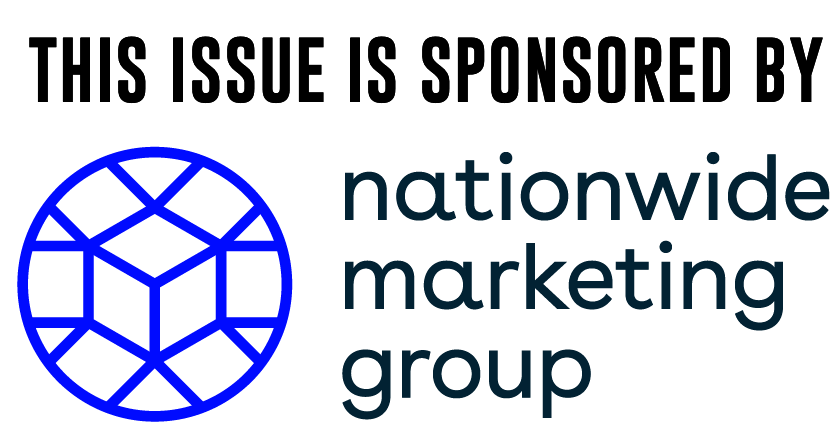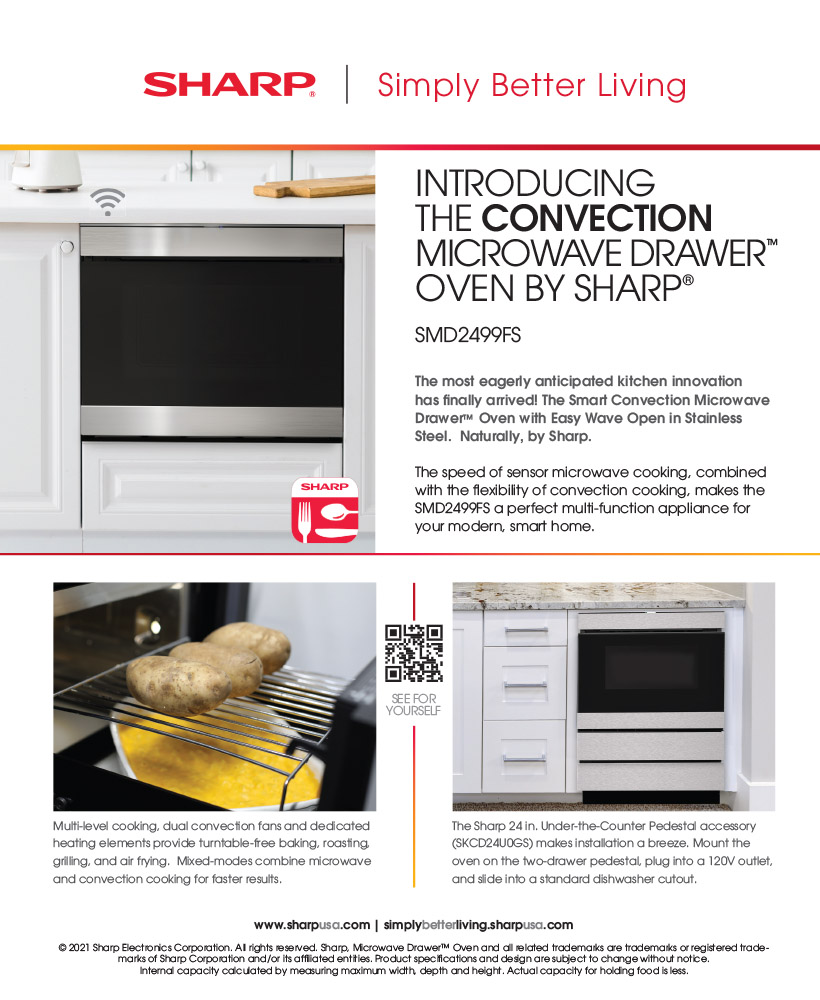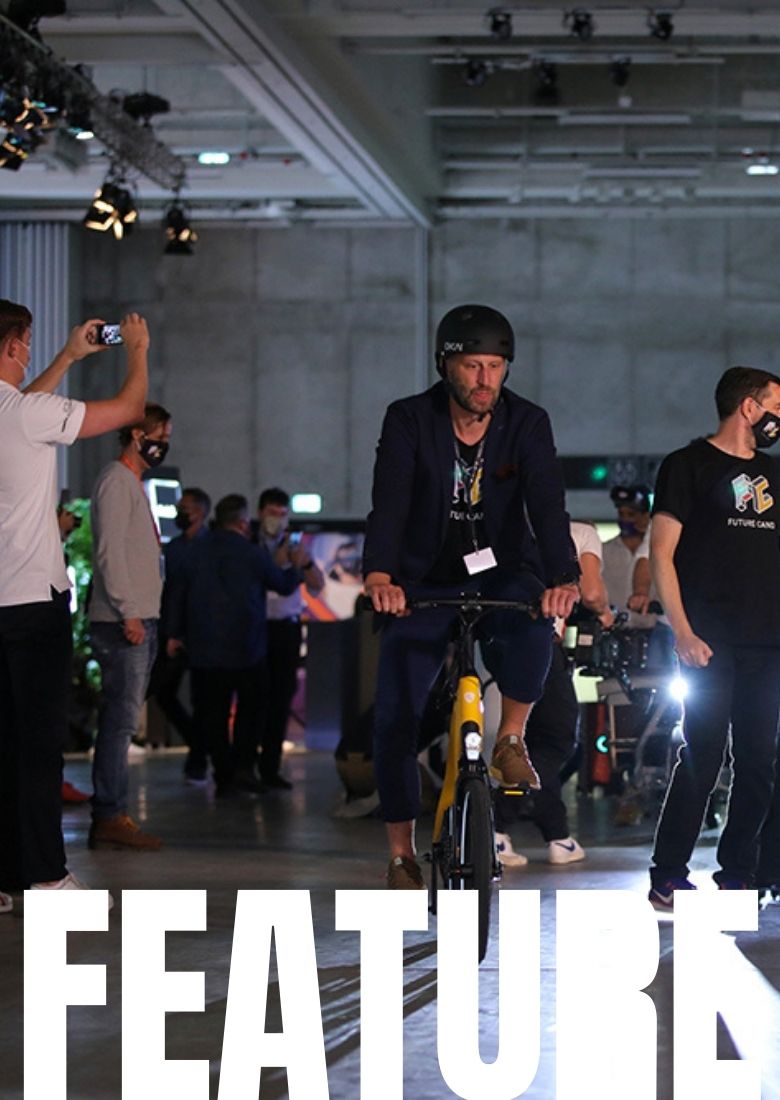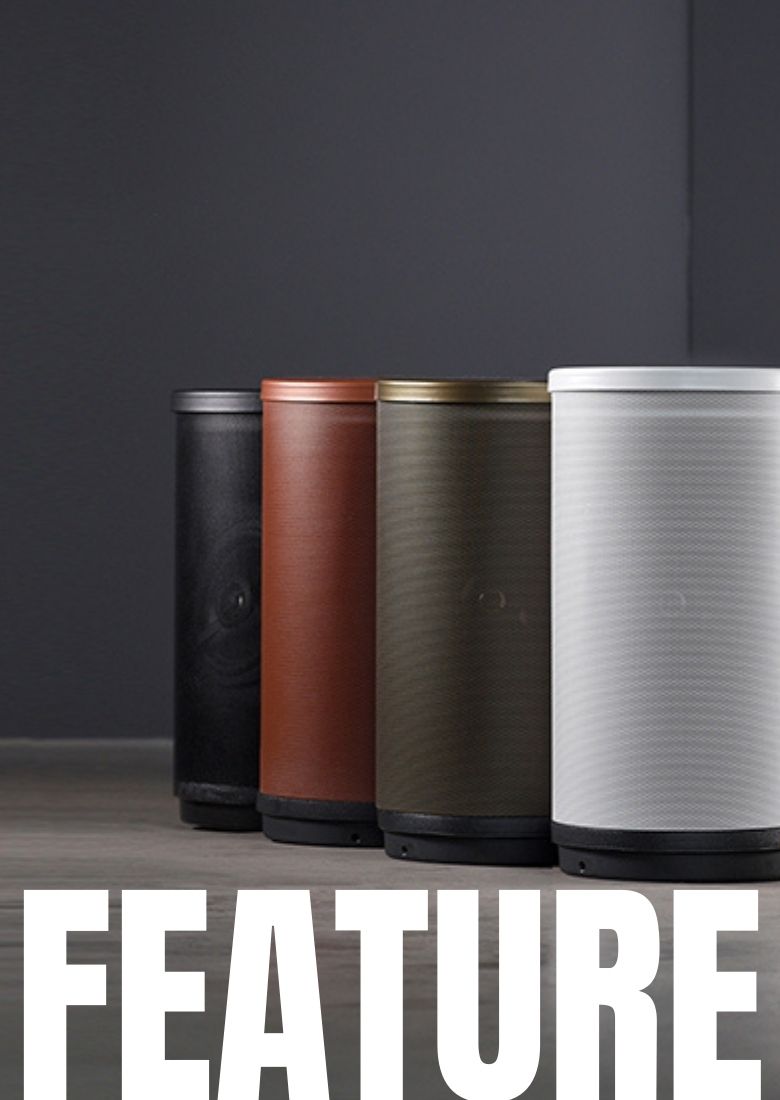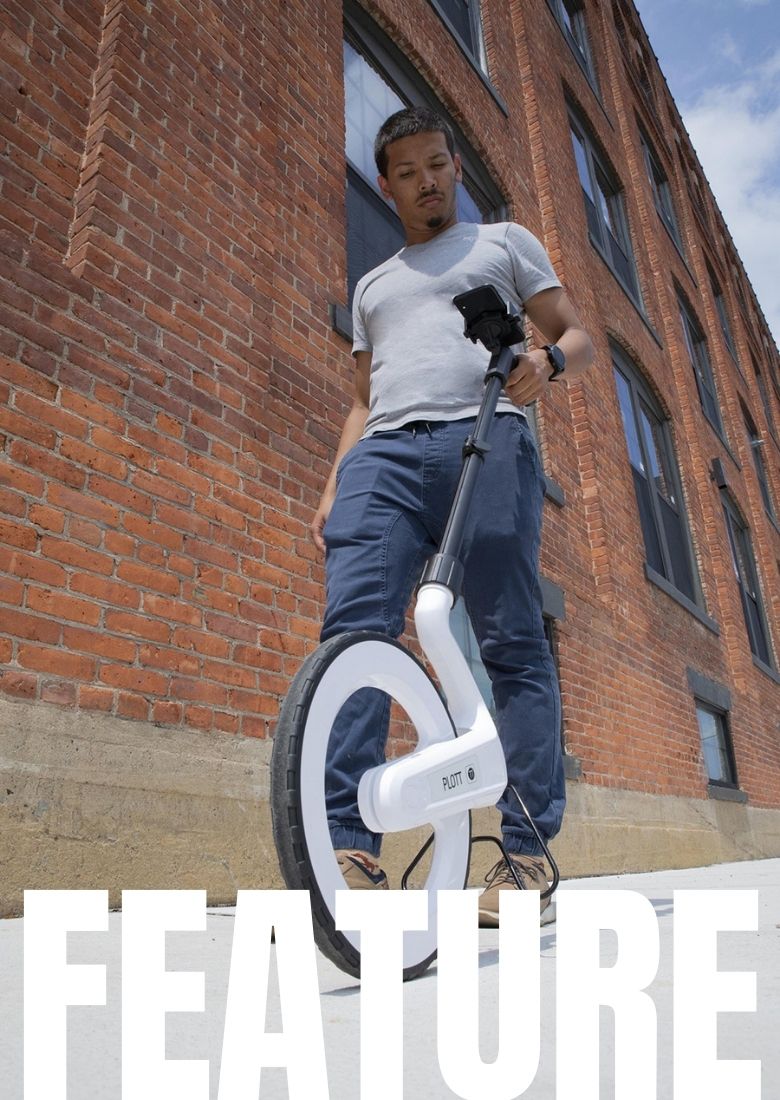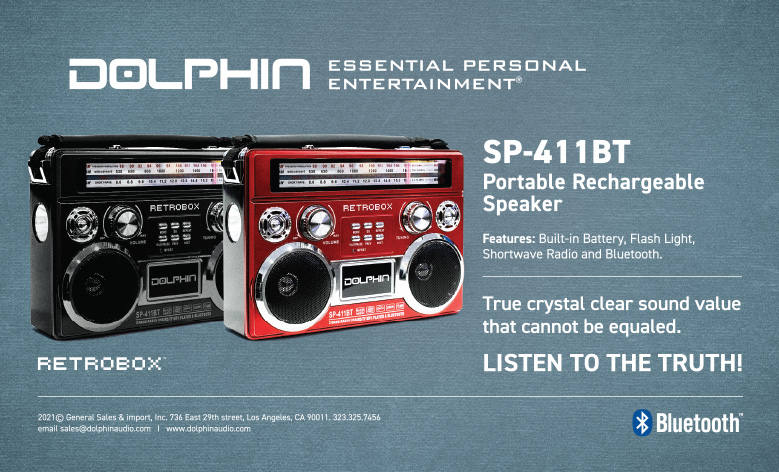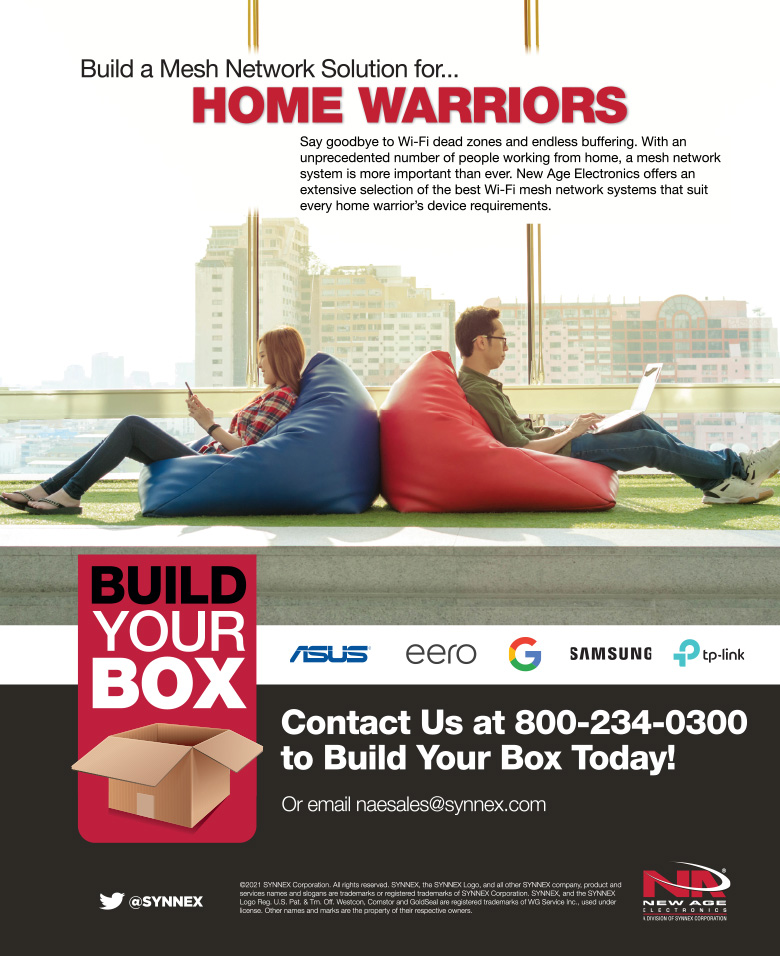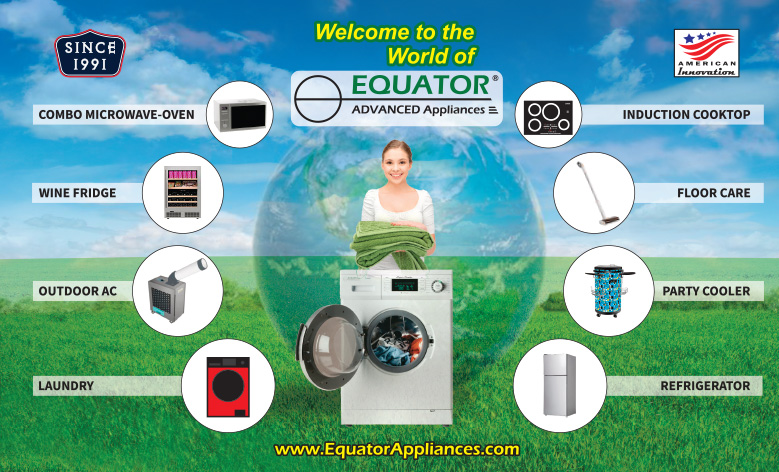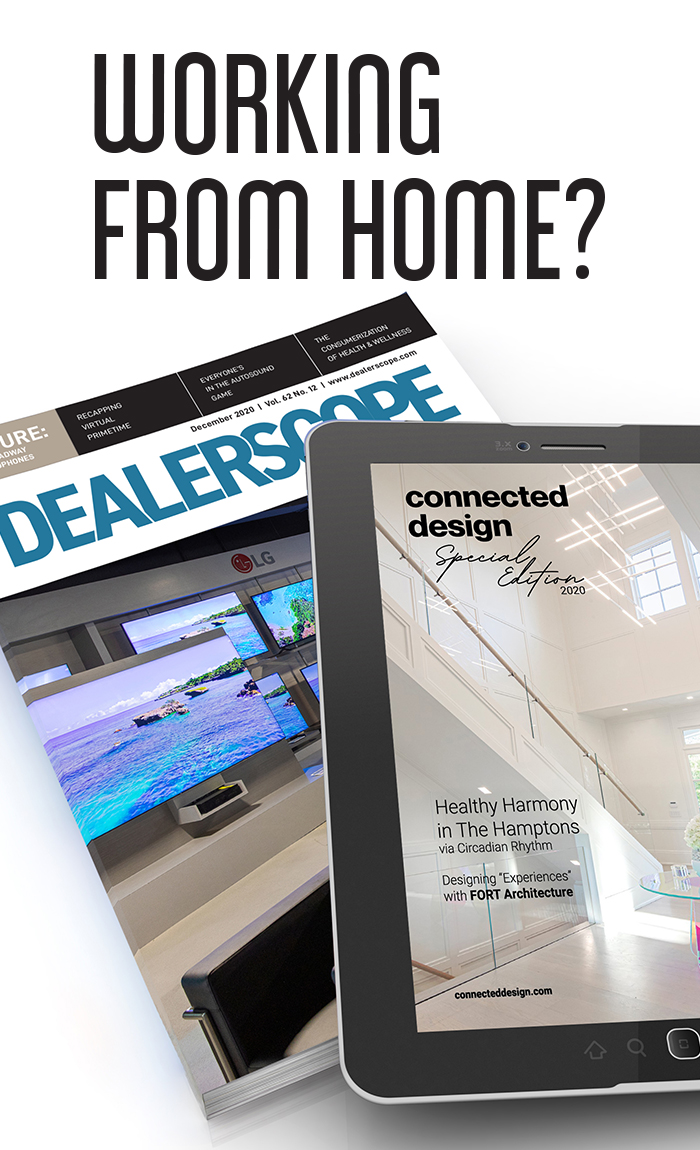In this Issue: This year’s “Most Influential Buyers” share their thoughts on what’s trending in technology, which products they’re seeking out, and how they make purchasing decisions. Then, we review Elon Musk’s upcoming Starlink satellite Internet service, and canvass retailers to discuss how they’re getting around the chip shortage. And don’t miss our eight-page Health & Wellness special, where we cover everything from Beauty Tech to the FDA’s process for approving health gadgets.

We Help You Look Your Best!

Whenever I go to the electronics and department stores, I am always surprised to see how many new Health and Beauty items retailers have in their mixes — items that will make sure customers are trim and that their pulses are on point, as well as tech to keep them young, fit, and beautiful. This category is here to stay. So it’s with pleasure that we introduce our section on “Health and Beauty” tech. Read through this specialized content to see why this category is becoming a retailer’s staple.
In this issue, we also celebrate the “Most Influential Buyers” at retail. These honorees are the cream of the crop; make sure that you check out their profiles. Giles Sutton, Interim Co-CEO, CEDIA, writes an excellent and thorough piece on how dealers can and must help their customers integrate smart appliances into the connected home. Be sure to also read “5 Things to Listen for When Auditioning a Soundbar System,” where you can see what is important to the consumer in this audio category.
On the international scene, we look at SHIFT, the mobility area of IFA, and what is planned for September in Berlin. Here we will learn about the thought leaders in every element of mobility. The Future is here.
Lastly, we welcome an addition to the CT Lab family. Erinn Loucks is now Chief Editor for our sister publication, Connected Design. She comes from the NKBA’s magazine. Erinn will also be a monthly contributor to Dealerscope. In August, she will give us a preview of probably the first in-person show many of us will attend this year: CEDIA Expo. I look forward to seeing many of you there in Indy.
As always, please feel free to get in touch with me at tmonteleone@ctlab.media.
Tony Monteleone, Publisher
A WORD FROM OUR EDITOR IN CHIEF
Travel is Back: Do You Know where Your CE Accessories are?

From higher airline prices and sold-out hotels to long lines for hikes at National Parks, the signs that travel is back are everywhere. According to a recent report by Coresight Research, 62 percent of U.S. consumers surveyed said they planned to travel domestically through the end of September. (Interestingly, only 7.4 percent said they planned to travel internationally, which suggests that travel restrictions are still hampering that market.)
Leisure travel aside, the return of in-person industry events — CEDIA, CES, Web Summit — suggests an uptick in business travel as well. No surprise, considering that 65 percent of business travelers surveyed considered in-person events extremely important and 67 percent found virtual events to be less valuable than in-person events, according to Parks Associates.
All this serves as a boon to airport-, hotel-, and resort-retailers, which have suffered tremendously during last year’s pandemic-induced drop in travel. According to Coresight Research, gift, novelty, and souvenir stores suffered a massive 80 percent drop in sales year-over-year in April, but have since rebounded to near-2019 levels, while sales at airport retailers, specifically, dropped more than 60 percent year-over-year. The report estimated that airport retail sales will grow by $10 billion this year versus last year. It’s no wonder that airport CE retail chain InMotion announced in July that it plans to open 18 stores in U.K. airports, as well as expanding the InMotion brand to hotels, resorts, and casinos in the United States.
Not all headphones, power banks, charging cables, and mini-Bluetooth speakers are purchased “planeside” after travelers go through security, however. And since the bulk of this year’s expected travel will be domestic, it’s likely that the transport method of the day will be by car, and that the gadgets and accessories that U.S. consumers bring along on the voyage will be of the road-trip-friendly variety.
If you’re an independent retailer, that means making sure that you have that new pair of noise-canceling cans or smartwatch in stock. Given the chip shortage and the ensuing challenges around procuring products, any store that has what consumers want right now will have an immediate edge. This strategy is “key” to success in today’s competitive CE retail landscape, according to DataVision CEO and Founder Jimmy Garson, whom we interview in this month’s “Retail on the Run.” As he tells it, providing a quick turnaround for sales and repairs is one of the reasons his business continues to thrive after 31 years.
One last thing: As the tech correspondent at Travel + Leisure for nearly a decade, I had the privilege of putting the latest travel-friendly gadgets through their paces month after month. While my voyaging over the 18 months has been limited to two coast-to-coast flights and four long-weekend road trips, I still keep a running list of my favorite travel gadgets. At the moment, the top three I never leave home without are: the Jabra 85t noise-canceling earbuds (seamless pairing, stellar sound-blocking); the Acer Swift 5 laptop (super slim and small 14-inch Full HD screen that gives serious bang for the size and weighs just 2.29 pounds); and the Elecom CapClip travel mouse (this ingenious hors d’oeuvre-sized Bluetooth mouse is small enough to fit on an airplane tray table and comes with a clip case to attach to your laptop screen). As I head out to industry events in the coming months, I’ll be taking notes on the electronics I bring with me. Make sure to watch this space, where I’ll continually share my portable picks.

Tom Samiljan
INTERNATIONAL PERSPECTIVES
Future Format
The 2021 SHIFT Mobility convention debuts
as an in-person, mixed reality event.

BY PHILIPP SOHMER
SHIFT Mobility, the annual conference and industry pow-wow that focuses on next-gen transportation, will run as planned on September 2nd and 3rd as an in-person event in Berlin, but with an intriguing and cutting-edge twist as a mixed reality convention far beyond the traditional trade fair.
“Mobility is changing fast, [and] the way we talk about it, too,” says Hans H. Hamer, CEO of SHIFT Mobility. He and his team have tackled the challenges of COVID-19 by launching this groundbreaking new format. From a mixed reality studio in Berlin, SHIFT will visit the coolest brands, the fastest thinkers, the most innovative startups and operate simultaneously as a physical and digital global event. Renowned experts such as Andreas Loeschel (advisor on energy transformation for the German Government and IPCC), Andrew DeWit from Rikkyo University Tokyo, and Scot Wingo (Forbes Technology Council) are among those mobility experts who will present either in Berlin or virtually. Speakers will share insights on topics such as sustainable mobility, software-defined vehicles, and new dimensions of transport.
“It has never been more important to talk about the future of mobility,” says Hamer, who has positioned SHIFT Mobility as the up-and-coming brand over the past couple of years. Despite the challenges of running an event over the past year and a half, Hamer has been adamant that the 2021 SHIFT Mobility conference take place as planned, and has found ways to expand the platform throughout the year. His strategy has been to set up a timeline with more boutique satellite events in Hamburg and Tel Aviv later this year, as well as integrations with CES and SxSW in 2022.
In recent years, SHIFT Mobility has assembled inspiring thinkers and doers such as Renzo Vitale (BMW Group), Michael Lohscheller (Opel), François Bausch (Deputy Prime Minister of Luxembourg), and many others in Berlin. These experts have not only discussed the most fascinating and promising trends in transportation, but have also critically reflected on the big picture around the transformation of society through sustainable mobility and living.
“The transition to renewable energy and mobility is bigger than the Industrial Revolution,“ says Auke Hoekstra, the director of ZenMo Simulations, who will speak at SHIFT this year. Hoekstra is one of the leading thinkers regarding electromobility, and epitomizes the spirit and the motivation behind SHIFT. For this reason, there will also be a focus on renewable energy and new urbanism this year, with the overall headline of the conference being “mobility meets tech.”
TRADE SHOWS
CEDIA Expo Returns With New Programming Features
The residential technology show is set
for this September in Indianapolis.
BY ERINN LOUCKS
(Main Image) At Booth #4344, Leon Speakers is launching the Terra LuminSound TrLs50 — a revamped version of its Ls10 outdoor speaker with a new exterior design and six new finish options.
After taking place virtually in 2020, CEDIA Expo is due to return in person September 1–3 at the Indiana Convention Center. The show will bring together more than 10,000 technology integrators, designers, and construction professionals, and include more than 300 exhibitors.
This year, the show will build on existing elements along with introducing several new programs. The CEDIA Expo Smart Stage is one of the returning features, serving as the home for 17 panel discussions, programs, and award ceremonies. Topics include wellness, business intelligence, and multi-family housing solutions.
Formerly called Innovation Alley, the Launchpad highlights brands that have been in business less than three years and have not exhibited at CEDIA Expo before. The Launchpad exhibitors are automatically entered into the TechStarter program, where brands will pitch products and services for a chance to be chosen as a “TechStarter FIVE.”
Also debuting at the show is the Innovation Hub, a programming venue showcasing case studies — particularly on ‘resimercial’ projects — through 25 sessions across three days. Topics will include home theater, lighting, work from home, and security — all areas that have grown in relevance recently.
“It’s hard to believe, but we’re closing in on two years since the last in-person CEDIA Expo and now — more than ever — we know there’s a need for community, connection, and getting back to business,” said Jason McGraw, Emerald Group vice president, CEDIA Expo & the Kitchen and Bath Industry Show (KBIS). “We’re all eager to connect again on a human level and get back to face-to-face events as we celebrate everything we value as a community together again.”
Returning brands will offer game-changing products and essential networking for attendees. The PowerHouse Alliance, at Booth #4207, will offer an opportunity for its members, vendors, and dealers to connect. SurgeX has plans to showcase its power protection and conditioning equipment at Booth #4149 to demonstrate the value and importance of a solid power foundation. At Booth #4344, Leon Speakers is launching the Terra LuminSound TrLs50 — a revamped version of its Ls10 outdoor speaker with a new exterior design and six new finish options.
Companies debuting at CEDIA include PantryOn at Booth #3035, an automated kitchen pantry that organizes and monitors inventory via an app and notifies homeowners when products need replenishing. Also showing at Booth #2735 is Guard Dog Solutions, an AI-powered network security system, and at Booth #2729, Orro is presenting a human-centric smart lighting system.
CEDIA Expo 2021 registration is open now for attendees and exhibitors.

MOST INFLUENTIAL BUYERS
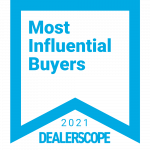
Dealerscope’s 2021 Most Influential Buyers
COMPILED BY NANCY KLOSEK
Like a train, the consumer technology field constantly races forward at a breakneck pace. The great minds and companies that spark innovation rarely take a moment’s rest. Buyers are the conductors of the consumer technology train. By keeping their finger on the industry’s pulse to find new products, models, and vendors, they provide it with direction.
The 2021 Dealerscope Influential Buyers Awards seeks to put a spotlight on these tireless individuals who possess the vast relationship network and foresight necessary to act as trendsetters within the consumer technology field. Nominated by their peers, these eight buyers are being recognized not only for their familiarity with technology, but also for their outstanding connections with others in the industry. We have asked our honorees to share with us their buying philosophies, and additional insights from their time in the business. The profiles you will be reading on them provide an invaluable look into the methods of their success. Congratulations to all the 2021 honorees!

Joe Feregrino,
Electronics Buyer,
Nebraska
Furniture Mart
Career History:
Joe Feregrino’s career in retail began 15 years ago at NFM where he started as an administrator in the buying department. Today, as an Electronics Buyer at NFM, he oversees the Home Audio and Portable Audio categories. He manages the merchandising and buying decisions, store presentations and marketing strategy for all locations, including the web. He is also a board member on the CTA Audio Division Board, and a member of the ProSource Audio Committee.
He says that what has kept him engaged and involved in the industry is “the people that I meet and relationships I have built, as well as the committee and board I sit on… I have always had an appreciation for music and movies, but being in the audio industry has really elevated my appreciation and turned it into a passion. It excites me to see and experience all of the latest and greatest products and technologies!”
Buying/Business Philosophy:
“Everything begins and ends with the customer.
“[My job’s high points include] the collaboration with vendor partners that share my passion for the audio industry. The success we have had collaborating on new products, displays, marketing plans and merchandising gives me great satisfaction. Together, we help customers improve their lifestyles.
“Cultivating strong vendor partnerships and collaboration is key. I keep an open mind to new items and ideas, while also visualizing the long-term potential and impact of a brand and its products. I share my goals and expectations so all involved understand how we can partner together and define success. Staying actively involved, providing suggestions, and giving regular feedback to my vendor partners on how we can improve is essential to achieving strong results. I am committed to the success of not only my categories, but also of my vendor partners through our mutually beneficial programs and partnerships.”

Anton Gouws,
Senior Buyer –
Consumer Electronics,
Makro South Africa
Career History:
Anton Gouws has 23 years’ experience in Consumer Electronics, having held various positions in retail operations (Sales – Management); after 11 years he became a buyer. In the last 13 years, he has been a buyer for Audio Equipment, Headphones, Navigation, Wearable Tech, Networking Equipment. Action Cameras, CCTV, Streaming Devices, Drones, Smart Home Automation and Thermometers. “My focus remains on Innovation and connectivity,” he says. He is currently the Consumer Electronics Product Specialist Buyer Makro SA (Division of Massmart South Africa powered by Walmart International).
Buying Philosophy:
“My novelty-seeking personality drives my need for innovation and to remain up to date with the latest international trends and domestic market needs. I focus on building interpersonal relationships with my supply chain on a solid foundation of trust. I have remained engaged in this sector due to the excitement it has to offer and the solutions to make people live better. In order to be a market leader you have to offer consumers differentiation, remain innovative and competitive and focus on win–win, profitable relationships to achieve the goals of the organization and your own objectives. The most rewarding experiences for a buyer is to see the joy on consumers’ faces when they use your innovative products. Delivering on customer centricity and creating a brand with supplier-partners are rewards in themselves. I am passionate, goal-oriented, determined and loyal. I also believe that you have to engage with everyone, as consumers, suppliers and forum speakers can educate you. To be successful as a buyer, you have to persevere even under all conditions, and find products that offer consumers solutions. I work closely with my suppliers during the difficult times and to find alternative, trend-based products to achieve our financial goals and overcome adversity.”
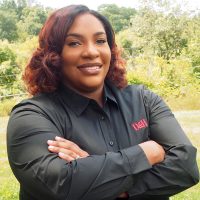
Danielle Gray,
Buyer,
D&H Distributing
Career History:
Danielle Gray has been in the retail consumer electronics industry for more than a decade, joining D&H in one of the company’s distribution centers. She understands the industry from all angles, having gone full circle, from loading products to buying products, providing her with a broad perspective on the inner workings of the industry. Danielle quickly rose to a position as an assistant buyer, and later, to full-fledged buyer, applying her intellect and personability to create strong, long-term relationships with manufacturers — relationships that she says are her favorite part of the business. She currently drives key retail categories including televisions, flat-panel displays, and home and portable audio, which have grown year-over-year. That’s in addition to areas of future opportunity, such as power protection, cables, and surveillance/security, which ensure that remote home environments can meet the simultaneous business and entertainment demands of a post-COVID-19 world.
Buying/Business Philosophy:
Danielle’s supervisors rave about the dedication she’s shown to her positions, which has helped to build her sharp insights into the supply chain. She understands and successfully executes on departmental and company goals and metrics, treating each strategic vendor relationship with care and analytical precision, immersing herself in the details of her accounts down to the SKU level. She is self-motivated, detail-oriented, and gracious in welcoming collaborative input. D&H’s leadership says it feels lucky to have her as part of the team.
From Danielle: “I truly enjoy the people that I work with, both at D&H and within the vendor community, which leads me to understand this dynamic industry better every day. I’ve seen people move from company to company, yet the relationships I’ve established have moved with them, bringing fresh ideas and new investments to D&H as our partners evolve. Building those relationships is the core function of my job, and it’s what I love best about it.”

Kim Jacobsen,
Senior Buyer,
Nebraska Furniture Mart,
Omaha
Career History:
Currently, Kim Jacobsen is the Senior Buyer for the TV category, but NFM has been her home for 20 years. With an Interior Design background and education, Kim’s career started in the Master Bedroom category of the Furniture division, then later pivoted to Business. She says, “After holding a variety of positions, working alongside some of the best in their respective industries, I have realized that the absolute best education and experience I could hope for has come from the rich history and culture of the people of NFM.”
Buying Philosophy:
“I made my home in electronics, ironically, the most unexpected and uncomfortable place I could think to be and create a career. But 20 years later, I can’t imagine being anywhere else. The fast pace creates an energy that is exciting, and though it has challenges, overcoming [them] is rewarding. Often, I’m in awe of having a front-row seat to the innovation happening right in front of my eyes.
“Personally, I have an unconventional style and a knack for testing my boundaries, but I believe that ability to push the envelope is what has made me successful. It requires a bit of tenacity, resiliency and adaptability but it’s encouraging to be allowed to think big and always strive to be and do better. There is a restlessness to never be complacent and always strive for higher expectations.
“The biggest thing that keeps me coming back are the relationships I have built across the industry, with my NFM teammates and my Vendors partnerships. No one person can be successful without the support of their team, and I’m fortunate to have a great team, supportive vendors, and to work for an amazing company.
“NFM is a great place to collaborate and to innovate, and I am proud of the many successes we have had, from marketing, merchandising, product showcases and events over the years, and am excited to continue partnering to improve customers’ lifestyles.”
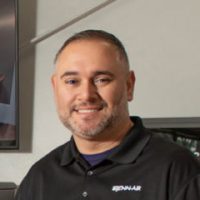
PJ Orsini,
Owner,
Orsini’s
Career History:
PJ Orsini is the third-generation principal of a 73-year-old independent home store. Orsini purchased the business in 2016 from his family, and in 2019 moved into an 18,000-square-foot location with an 8,200-square-foot showroom, expanding from an appliance store into a complete home specialty store. “I am the third generation in my business,” he says, “and we have expanded from an appliance store into a home center, offering cabinets, countertops, bedding, flooring, outdoor living products, and much more. I enjoy being the catalyst of evolution in our business model, and we work hard to keep ahead of trends both within the industry and from consumer behaviors.”
Buying/Business Philosophy:
“‘Create the demand for what is on hand.’ This applies both to my sales team as well as to how I need to diversify our product offerings and flooring strategies. I do not believe in having a set floor model mix, as there are too many external variables that challenge a fixed set. So [I belive in] being nimble enough to change the product selections based on what the manufacturer inventory allocation allows.
“[My job’s high points include] surviving and thriving during the COVID pandemic. I was very proud to see the relationships we have cultivated with our manufacturers, Nationwide Marketing Group, and our professional partners, which allowed us to become COVID-ready in a very short time. I was able to create a great virtual experience online for the consumer that was safe and effective, while navigating through the inventory allocation issues we are all experiencing.
“[What makes me an effective buyer is that] I don’t believe anyone will out-work me. I am constantly looking at consumer buying trends, industry statistics, and using that info to create a go-to-market buying strategy that is supported by consumer buying habits and patterns. I also look at the very successful independent retailers in my industry, along with associated products and some industries that have nothing to do with the home, but are iconic within their own markets, to see what they are doing to stay on top as well as what they are doing to be in front of what is coming next.”

Paul Roth,
Director
of Merchandising,
BrandSource
Career History:
For the first 10 years of Paul Roth’s career, he worked for a national retailer, “where I learned the fundamentals of retailing/purchasing and broadened my skill set. It has been over the last 12 years, however, when I made a move to the independent side of the retail Industry, that my career really took off. My current role, working on the buying side for independent retailers here at BrandSource, affords me the opportunity to continue to grow as a buyer.”
Buying Philosophy:
“Independent retail buyers like myself have a broad scope of responsibilities that include relationships, purchasing, marketing, leadership, merchandising, logistics, etc. Due to the streamlined structure of independent retail organizations, I have worn many hats and have made a significant impact in the success of many businesses. Assisting independent retailers gives me the honor of helping others achieve the American dream by running a profitable business.
“I have been truly humbled to play a part in the bottom-line success of so many businesses I have been associated with. I look forward adapting to an ever-evolving marketplace, and to continue to elevate my game as my employment journey unfolds.”

Tyler Scherner,
Director of Purchasing,
DAS Companies, Inc.
Career History:
Tyler Scherner is DAS Copmanies, Inc.’s Director of Purchasing. He oversees a team of nine, collectively managing several categories within DAS, including consumer electronics, consumables, and toys. “Having a great team is everything, and I am very proud of mine,” he says. “While I have a comfort level in multiple categories, consumer electronics is my passion! It has been a constant area of responsibility throughout my career, and I still love the challenge. Things are constantly evolving, and it takes a continuous effort to keep up.”
Buying/Business Philosophy:
“Three things come to mind, when trying to define my buying style.
“First, I do not believe in keeping things status quo, ever. Success is planned. I have several categories that are having record sales years in 2021; but even with successful categories, it is critical to be strategic and forward-thinking. Record sales in 2021 means there is going to be a ton of pressure to keep setting records in 2022. As such, it is vital to always have one eye on the future.
“Second, this is a relationship business, and I believe in those relationships being genuine. For success to be truly achieved, all parties must be winning. As such, I try to see the point of view of others, and then I develop my game plan accordingly.
“Third is my willingness to take calculated risks. Every decision I made is strategic, and I try to look at all the possible angles. I am an imperfect person, and not every decision I make is going to be correct; so, the key is to maximize the wins, and to minimize the losses. Sounds stupid simple, because it is, but it is a step that not everyone takes. Some people are seemingly taken off-guard when something does not perform as expected, and then everything they do is reactionary to that fact. My focus is to be proactive, and to have already planned for every possible scenario, as opposed to being reactionary.”

Cassaundra Wertman,
Senior Buyer,
Almo Corporation
Career History:
Cassaundra (Cassie) Wertman works on Almo’s New Product Development Team and is responsible for sourcing products that Almo directly imports into the U.S. and sells under private-label brands, handling everything from purchasing to forecasting to marketing.
She attended Towson University and graduated with a Bachelor of Science degree in Business Administration and Marketing. Before Almo, she was Project Coordinator at US Construction and in charge of managing site work, coordinating material deliveries, approving invoices, and scheduling subcontractor work.
Buying Philosophy:
Cassie excels in all areas of her role – her energy and excitement are infectious and her talent is limitless. She is responsible for a number of categories — the largest being outdoor furniture — and has played a successful, integral role in all of them. She is also handles outdoor heaters, electronic fireplaces and even sheds, chicken coops, dog houses, and bunny hutches, which are sold online through Almo’s E-Commerce Fulfillment Division and through various dealer channels.
From Cassie: “I work closely with suppliers — it’s critical to have a strong relationship with open and honest conversations about the market, the trends and the influencers. I want to make sure we are capitalizing on attracting all the right buyers to our products. It’s also important to partner with companies that provide the highest-quality products, including top craftmanship, and the best materials that are easy to assemble and long-lasting.
“I have a passion for outdoor furniture and one of my greatest achievements at Almo was growing this business area exponentially throughout the pandemic. I was also able to add the outdoor steel shed category to our Almo offering, which has grown to become a million-dollar business over the last year.
“My buying philosophy is truly an extension of Almo’s way of doing business, and that’s focusing on people and relationships first. It boils down to taking the time to cultivate partner relationships and go the extra mile. Additionally, as we’ve all learned over the last year, it’s important to be nimble and adaptable, because product situations are fluid and can change at a moment’s notice.”
AUGMENTED REALITY
How To Solve Consumer Problems With AR
Augmented reality can improve the customer experience and create brand awareness, but advancing the technology requires a collaborative approach.
BY DAVID XING, FOUNDER, PLOTT
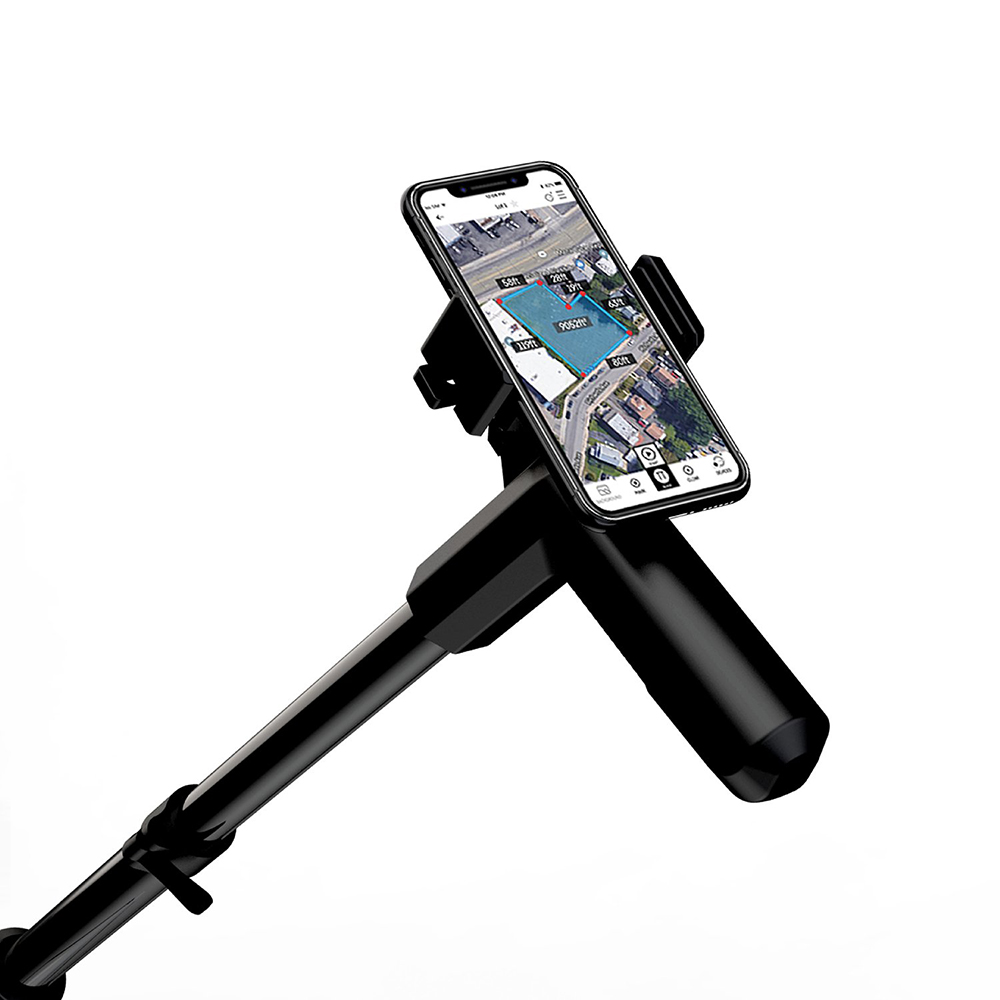
Plott’s Carta is a digital measuring and mapping wheel that can create blueprints of a space from 2D images.
Five years ago, augmented reality (AR) entered the mainstream via phone-based applications. Despite mainstream hits such as Pokemon Go, which was a rudimentary workaround compared to today’s implementations, AR in general struggled with slow adoption and education hurdles. Even as the early hype subsided, retailers looked for practical use cases for AR, realizing that it had the potential to increase sales conversion by enabling consumers to see how a product or experience — furniture, clothing, consumer electronics — would look in the context of a home or other real-world setting.
Today, we’re at the beginning of a new golden age of technology. AR, AI, Edge Computing, 5G — it’s all converging. Amid rapid changes, the key to integrating technology into retail in ways that drive sales is to focus on constants.
Trends come and go, but the biggest consumer problems remain constant. The AR industry’s value proposition also remains constant: We help people see things that don’t yet exist and bring “the promise” to life.
Seeing Instead of Imagining
In a 2019 Nielsen global survey, consumers listed augmented and virtual reality as the top technologies they’d want to assist them in their daily lives, and just over half (51 percent) said they’d use the technology to assess products.
“Try before you buy” is the most practical and immediate solution AR offers.

Virtual try-before-you-buy experiences skyrocketed during COVID-19. These visualizations range from previewing furniture in your home from brands such as Wayfair and Home Depot to testing what fashion, glasses, or even makeup will look like when worn. MAC Cosmetics shared that the demand for its virtual try-ons feature online has tripled since the pandemic began, pushing forward years of innovation and adoption of AR within retail in a matter of just a few months.
When consumers see something rather than just imagine how it could be, they’re much more likely to engage with it, vastly improving ROI. Shopify released data showing that products featuring AR content saw a 94 percent higher conversion rate than products without it. Similarly, Houzz reported that people who engaged with their AR tool were 11 times more likely to purchase, and spent nearly three times more time in the app.
At Plott, the extended reality (XR) company I founded, we use AR technology to seamlessly take users from conceptualizing to designing to completing DIY projects. For example, consumers can overlay a picture frame they like on their own space via the phone viewfinder, then purchase it, and then utilize our integrated hardware and indoor measuring solution, Cubit, to guide them as to precisely where and how to hang it on the wall. Similarly, our digital measuring and mapping wheel, Carta, can help complete similar tasks outdoors and on a larger scale.

Plott’s Cubit uses AR to help you measure, design, and create indoor spaces, or just where to hang art on a wall.
Delivering Brand Awareness
Another consumer problem AR helps solve is making buying decisions. In a crowded (and sometimes copycat) market, it can be difficult to choose one product or experience over another. Often, the brands who win are the ones who know how to stand out.
In one example, the NFL recently partnered with Nickelodeon to bring some of the channel’s signature slime to the football field virtually, maximizing the co-viewing appeal for families. In another, BON V!V Spiked Seltzer generated excitement around a product launch by creating murals allowing passers-by to scan a QR code to watch a 3D vending machine where interactive animations come to life. The animations helped direct consumers to locations where they could buy the product nearby. We don’t know exactly how each of these campaigns performed financially for each company, but a recent survey from Havas stating that 84 percent of people expect brands to create content indicates that activations such as these are not only welcomed by consumers, but are anticipated to garner their engagement.
Unsurprisingly, one of the most popular uses of AR is social media filters, available across platforms including Instagram, Facebook, Snapchat, and TikTok. With users spending an impressive 75 seconds on average interacting with AR content, these filters are a powerful tool for driving engagement and brand awareness across platforms. By their nature, they require users to participate and share. Even five years ago, the Taco Bell Cinco de Mayo activation, a Snapchat Lens feature that turned users’ heads into giant tacos, resulted in more than 224 million views in one day.

The NFL recently partnered with Nickelodeon to virtually bring some of the channel’s signature slime onto the football field via AR.
Improving the Consumer Experience
AR can also help make customers’ lives easier in-store and post-sale. The 2019 Consumer Retail Technology Survey showed that 61 percent of consumers look for ways to save time while shopping, so retailers such as Lowe’s and Walgreens introduced AR indoor mapping. Shoppers can look up a product in their app, and arrows will then appear on screen to point them in the right direction. Post-sale, automakers like Hyundai and Mercedes shifted to AR-based user manuals, allowing drivers to scan an element of their vehicle and explain its functionality.
What’s Next, and How to Get There?
According to Grand View Research, the global augmented reality market is expected to expand at a compound annual growth rate (CAGR) of 44 percent by 2028 to hit $340 billion. In the face of such rapid growth, passion is the AR industry’s greatest asset. Consumers want to learn and experiment, and will look to retailers, manufacturers, and brands to give them an opportunity to do so.
All of these stakeholders are working on it, but making progress means working differently. Developers, retailers, and manufacturers are passionate about how they see the problem and how their AR solution addresses it, but it’s important to be wary of the “what comes first” scenario. Instead of thinking of steps to a solution in succession — technology first, then retail adaptation, or vice versa — we must think collaboratively. Developers, retailers, and manufacturers should experiment on a path forward together.
We’re now seeing how collaboration can propel adoption rates with augmented and mixed reality smart glasses. The enterprise and consumer worlds — across hardware, software, and services — are investing and have smart eyewear products in different stages of development. Some major use cases of augmented and mixed reality eyewear include remote worker enablement and industrial safety training. As a result, ABI Research reports nearly 28 million augmented and mixed reality smart glasses will ship in 2026.
One important way developers, retailers, and manufacturers can come together is to use our respective skills and reach to educate consumers. Mass education is what will lead to AR’s tipping point. How can we position it as a problem solver vs. a new technology that consumers may feel stressed about adopting? What use cases can we elevate to prove that AR isn’t just a trend? How can we collaborate with the passionate and the loud to influence the wider public?
The great news is that support is already abundant in the industry. Projects of all sorts — big or small, wild or conservative, unusual or expected — fuel excitement and progress. The viral popularity of Pokémon Go in 2016 was followed a few short years later by a $21 billion contract from the U.S. Army for AR glasses to help soldiers “fight, rehearse, and train” in one system. This move signaled both the legitimacy of the technology and the fact that it’s here to stay. When everyone, from the Dallas Mavericks to Snoop Dog to Ikea, is using AR, the public gets educated and excited.
If consumers understand that AR helps them make smarter buying decisions and save time, AR can also become a new way of shopping and living.

CE RETAIL TECHNOLOGY
August 2021 CE News

Amazon Stores Get a New Leader | Amazon has appointed Tony Hoggett to lead its brick-and-mortar business as senior vice president of physical stores. The retail veteran has spent the last 30-plus years with Tesco, the U.K.’s largest retailer, where he currently acts as the company’s chief strategy and innovation director. Hoggett will assume his position in January 2022 and report directly to Dave Clark, CEO of Amazon’s Worldwide Consumer Business.
Repeat Shoplifting Incidences Force Retailers to Rethink Store Operations | Organized crime sprees in the form of shoplifting have been popping up in major U.S. cities as worker shortages plague the country. Five Target stores in San Francisco have reduced operating hours as a way to get ahead of the profit losses and to ensure employee safety. The thieves often calculate the cost of their intended targets to ensure the items they are stealing fall below the felony threshold, so that officers cannot take action against them.


Retailers Welcome Child Tax Credits | Just as tax returns and stimulus spending offered some reprieve for retailers after a tough year, child tax credits are another welcome government initiative to continue the upward momentum. JP Morgan estimates that the monthly checks, which range from $250-$300 per child, will boost retail sales by 0.7 percent. Jim Sullivan, an economics professor at the University of Notre Dame studying the impact of the coronavirus pandemic on Americans living in poverty, told CNBC, “The retail sectors where middle- and lower-income families spend money are likely to benefit some from this.”
Consumer Prices Saw Biggest Spike Since 2008 | Prices increased 0.9 percent in June 2021, representing a 5.4 percent year-over-year increase and making history as the largest spike over a one-month period since June 2008. But unlike the “Great Recession,” which took place from late-2007 through mid-2009, consumers in 2021 are continuing to open their wallets. The reason prices are rising now is due to lingering supply-chain struggles brought on by the pandemic. The Biden Administration feels confident, however, that the inflation will taper off next year and into 2023, as supply and demand become more aligned.


Apple is Working on a Buy Now, Pay Later Option
Apple is leaning on Goldman Sachs in anticipation of a new “buy now, pay later” offering for Apple Pay purchases. The two companies have been working closely since the launch of the Apple Card credit card in 2019, but their latest venture actually won’t require the use of one. The project, internally coined Apple Pay Later, will allow purchasers the option of paying for items across four interest-free payments made every two weeks or across several months with interest.

AUDIO
Five Things to Listen for When Auditioning a Soundbar System
Focus on these evaluating elements to help your customers make the right choice.
BY PAUL HALES, President and Product Designer for Premium Audio Brands, Pro Audio Technology and Theory Audio Design.
So, you just sold your client the latest and greatest flat-screen TV. Now what? If your client wants better sound than TV speakers can offer – and they really should – the next decision is to decide between a soundbar or discrete speaker system. When it comes to sound quality, you can’t beat the soundstage and immersion of a good-quality 5.1 (or higher-channel count) system, but not everyone has the space or budget. The good news is that today, many of the latest soundbars offer high-end fidelity and aesthetics to match the latest flat-screen TVs, but don’t take up any floor space or break the bank. Whatever the case, it’s important that customers avoid blindly buying any speakers off the store shelf or online. Just like a car, TV, or other expensive electronics, audio is an investment worth testing out. The best way to help your client choose a soundbar system (or any loudspeaker system, for that matter), is to demonstrate different makes and models within their budget and then allow them to decide which they prefer.
My customers often ask me what they should listen for when auditioning soundbars and theater systems. In my opinion, when evaluating audio, it comes down to five different things to listen for. Here’s what I go over with them:
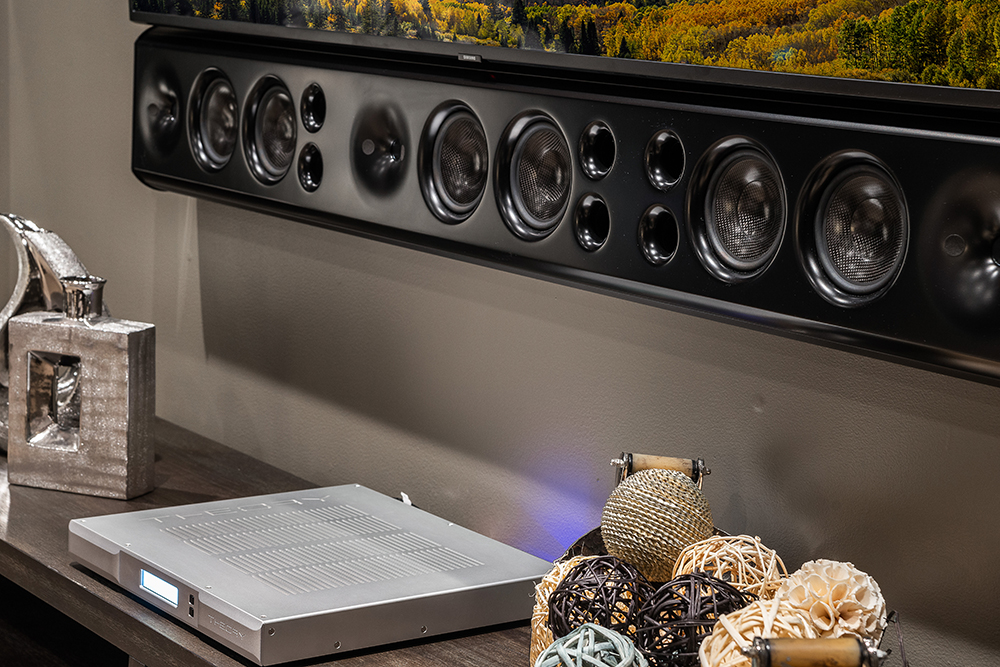
1. Naturalness
You should never be distracted by the sound of audio equipment. When listening to any kind of content, ask yourself: Does it sound ‘real’ to you? Is the sound balanced, with no emphasis on any frequencies – high notes, low notes, and everything in between? A good-quality soundbar system should sound like the real deal and make you forget it’s even there. It should never sound harsh, irritating, or distracting.
2. Detail and Resolution
Are the low-level sounds just as clear and intelligible as the loud sounds? Are the soft sounds audibly realistic, too? Can you hear the subtleties? Maybe it’s the flutter of an insect’s wings, a clock ticking on the far wall of the room, the nuanced texture of a delicately orchestrated score, or a car driving by outside. Just as in real life, you should be able to unravel low-level information in the background, not just what’s happening in the foreground.
3. Dynamics
Is there an easily discernable contrast between soft and loud sounds? This is an area where most audio systems falter. Real acoustic events such as the human voice, musical instruments, natural sounds like a breaking twig, or the slam of a book dropped on a tabletop contain a high level of acoustic energy when compared to silence (the absence of acoustic energy). We call the difference between the loud sounds and silence “dynamics.”
In real life, this rapid change from silence to sound gives these acoustic events life and snap, even on softer delicate sounds such as carefully plucked classical guitar strings. Dynamics give the sounds, even the softest ones, clarity.
When listening, ask yourself: When called for, does the system play both soft and loud with ease? Is the system still “lively”-sounding, even at extremely low listening levels? During loud passages, it shouldn’t feel like the speaker is pushed too hard or distorted, no matter what content you throw at it. And the soft moments should be just as engaging and lively as the loud ones. It’s thrilling to be engaged in a noisy action scene, but you should also be able to make out soft details and quieter dialogue without having to adjust the volume.
4. Bass Response
Can you feel – not just hear – the low notes in your core? In real life, the lowest-frequency sounds contain a lot of acoustic energy, causing us to feel as well as hear them. The right soundbar systems will ensure that explosions, double-bass notes in jazz music, and a jet engine flying overhead are visceral as well as audible. This tactile part of sound reproduction adds to the realism. And, most importantly, a good soundbar system should be able to reproduce those deep bass moments, effortlessly.
5. Immersion
Do you feel as if you’re in a real three-dimensional space? In real life, we experience sounds all around us, above us, and even sometimes below us. A good audio system should capture the “open” and “enveloping” qualities of natural sounds.
When listening to an audio system, does it seem as though all the sound is coming from one centralized spot (i.e., right in the middle, under the TV)? Or, is the sound “open,” and seems to come from wall to wall, floor to ceiling? Do any of the sounds seem to come from the sides, or even behind you?
With modern soundtracks, a good soundbar system can fully envelop you in sound, even with just three channels anchored to the front wall, causing you to forget that you are listening to audio equipment at all. The sound should not seem to emanate from the soundbar itself. Rather, it should feel unrelated to the soundbar and take on an open 3D quality that’s more like real life itself. It won’t seem as though you’re watching a movie or concert video; you’ll feel like you are in the scene of the film or at that live performance.

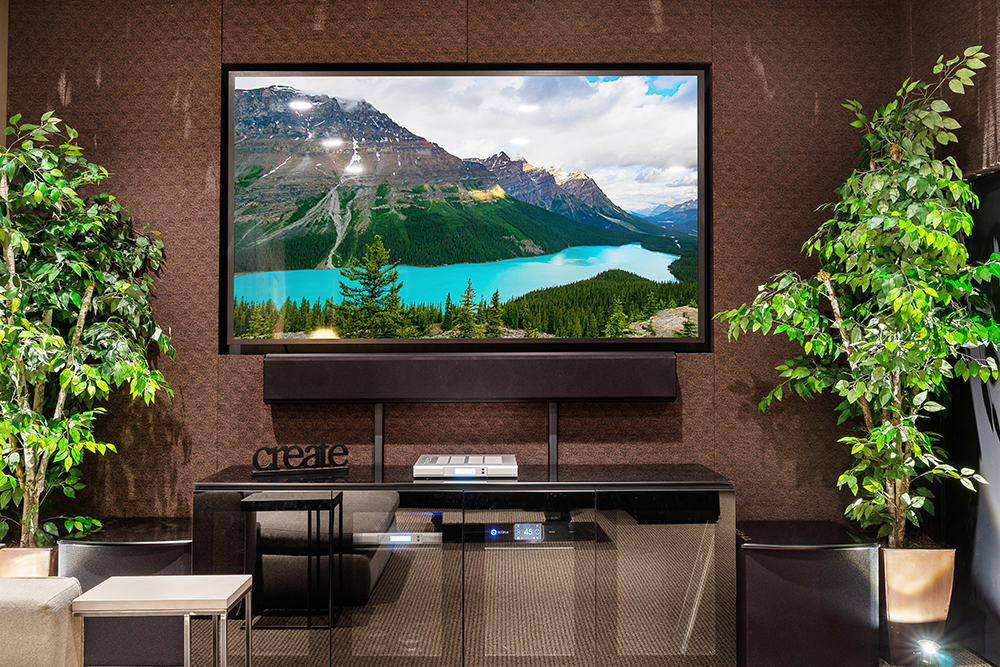
Choosing the right soundbar system is a very personal decision, and it’s important to allow your clients to try before they buy. A soundbar with the qualities described here will not only thrill them, but also transport them from their family room (or other space) right into the middle of whatever movie scene, video game, or live concert they are watching. The best soundbar system will do that for the listener every single time they sit down and turn it on.

UNBOXED
Starlink Has Potential — and Problems
Getting broadband Internet access to rural areas could be a boon to businesses and sales.
BY JOHN R. QUAIN
While Jeff Bezos and Richard Branson have been rocketing themselves into space, Elon Musk has been working on another space race. Launching thousands of satellites into orbit, Musk’s SpaceX is the first company to build out a low-earth-orbit high-speed Internet service dubbed Starlink. Intended to bring broadband to underserved rural areas, Starlink could potentially cover the globe.
However, after several months of testing, we’ve found that Musk’s service has more than a few kinks that still need to be straightened out.
Underscored by urbanites’ flight to the country during the pandemic, rural Internet access is lacking in many areas. Reaching individual homes miles from populated areas with cable or fiber optic lines is economically impractical, and cell towers are too few and far between for high-speed wireless. Enter the idea of low-earth-orbiting satellites.
How it Works
The Starlink plan is to use a constellation of thousands of satellites to deliver Internet service to remote areas at speeds of 300 Mbps or better. Unlike a HughesNet or DirecTV satellite, these are not geosynchronous or geostationary satellites, which typically sit in one spot about 22,000 miles above the planet. Starlink’s smaller satellites are not stationary and travel at about 340 miles above the Earth, substantially reducing the signal delay or latency.
Getting customers connected is still expensive. The Starlink package costs $499 for the satellite dish and a Wi-Fi router. Shipping and taxes put the initial total at $581.94 for our system. The service is also steep: $99 a month for unlimited Internet access.
On the other hand, the Starlink system is simple to set up. Push the dish’s pole into a supplied tripod, find an open piece of sky to aim at, string the cable to the included Wi-Fi router, and turn it on. The dish is motorized to make aiming adjustments, and heated to keep the snow off.
Whereas TV satellites require dishes in North America to be aimed at the southern sky, Starlink’s sats are currently clustered around the 49th Parallel, so its dishes have to look toward the northern sky and require an unobstructed view. That issue is made more problematic by the fact that the dish is restricted by an attached 100-foot cable, a length that will prove to be too short for many rural installations.

SpaceX is leveraging its experience in building rockets and spacecraft to deploy
the Starlink Internet System. (All images: Starlink)
Faster, With a Few Caveats
After months of hands-on testing as part of Starlink’s beta program, we found the technology delivers much faster speeds than rural DSL or traditional satellite service. We typically hit top download speeds of 200 Mbps and upload rates of about 40 Mbps. That’s hundreds of times faster than the 1.5 Mbps DSL connection in the same test location.
Unfortunately, Starlink suffers from millisecond dropouts, which kills video call services dead. Over countless Facetime, Skype, WebEx, and Zoom tests, calls would begin with broadband picture clarity, but within minutes, the Starlink dropouts would freeze the call. So while the service in its current form is fine for Web surfing and streaming 4K movies, which can be buffered, Starlink is not adequate for high-speed synchronous services like making video calls.
Starlink recently acknowledged some of these issues in a newsletter to subscribers. The company says as more satellites are sent aloft, reliability will improve. It also plans to fix its software so that the earth-based dishes can seamlessly switch to a different satellite in the event of a service interruption.
The Competition
The low-earth-orbiting technology still has lots of promise, so understandably there’s a lot of competition building in the Internet satellite space race. Amazon, for example, has plans for a similar service it calls Project Kuiper to deliver rural Internet access. Canadian firm Telesat has plans to bring similar services to maritime customers, and OneWeb in the U.K. wants to reach customers in the Arctic by the end of the year. And not to be left behind, the two Chinese companies, Hongyun and Galaxy Space, have their own low-earth-orbit initiatives.
As of July, Starlink had roughly 2,000 satellites circling the globe. SpaceX’s Falcon 9 rocket can put up 60 at a time, but it will take thousands more to deliver complete service. The company has FCC approval to put 12,000 satellites in orbit and applied recently to put up 30,000 more. In the meantime, Elon Musk has tweeted promises of 300 Mbps speeds and that the service may go live as early as August. Whether Starlink can cure its hiccups before then remains to be seen.
SUMMARY:

- Using thousands of satellites, Elon Musk’s SpaceX’s low-earth-orbit high-speed Internet service is designed to bring 300 Mbps or faster broadband download speeds to heretofore underserved rural areas.
- We found the technology delivers much faster speeds than rural DSL or traditional satellite service, but the initial setup and monthly subscription fee makes it a pricey option. We also experienced millisecond dropouts during video calls.
- The service is still in beta, and the company says many of these glitches will be ironed out as more satellites are launched, possibly as soon as August 2021.


Lessons on Digital Prioritization from Social Media Week
Social pros stress the importance of being selective and knowing when to say goodbye to profiles that no longer serve your brand.
One of the biggest misconceptions when it comes to social media is that, in order to achieve your brand’s full potential, you need to be active everywhere, all the time. As new social media platforms pop up on what feels like a yearly basis, brands are left questioning whether they should create an account to capitalize on new territory. But without taking a hard look at a few key factors, seeking to be omnipresent on social media can actually be one of the biggest recipes for failure.

Social Media Week Los Angeles was held as a virtual event from June 29 – July 1, 2021.
At Social Media Week New York earlier this year, Falcon.io’s senior strategist, Casper Vahlgren, referenced Reebok’s 2012 Facebook strategy as an example of how easily brands can go overboard with the number of accounts they have.
Almost a decade ago, the footwear and clothing company had a whopping 616 Facebook pages under its brand name. Not only was this approach putting a strain on the social team in charge of these accounts, but it was also confusing for consumers as well.
While this example may be extreme, it reveals to how all businesses have the potential to fall into the same social media black hole. The focus, instead, Vahlgren says, should be on long-term brand building.
“You don’t necessarily need to shut down profiles,” he says. “Just make a strategic choice around where to allocate resources.”
Setting realistic expectations around bandwidth and budget is an important first step and one that Alec Johnson, social media analyst for TikTok, touched on in his Meetup at Social Media Week Los Angeles in June.

Casper Vahlgren, Senior Strategist for Falcon.io, discussed selectiveness and prioritization as it relates to brand strategy at Social Media Week New York, held May 4-7, 2021.
Some brands have the capacity to assign one person (or even a team of people) to manage a single social account, while other brands may not have the same luxury. But that’s not to say a team can’t see some sizable organic growth with little to no budget — a feat that starts with knowing how to prioritize.
When investing money into social media is not a possibility, investing time into the right channels is the next best option. Having three strong profiles where your audience is most active is a million times better than having 10 different accounts that are inconsistent and lacking character.
The next step is to analyze and identify opportunities for growth (or lack thereof) to make an informed decision on when to create or and when to deactivate a social media account.
Coco-Cola took the latter approach, after data revealed that half of its 400 brands accounted for just two percent of its total revenue. CEO James Quincey decided it was time to cut back, and in doing so, Coca-Cola was able “bring stronger innovation to the table.”
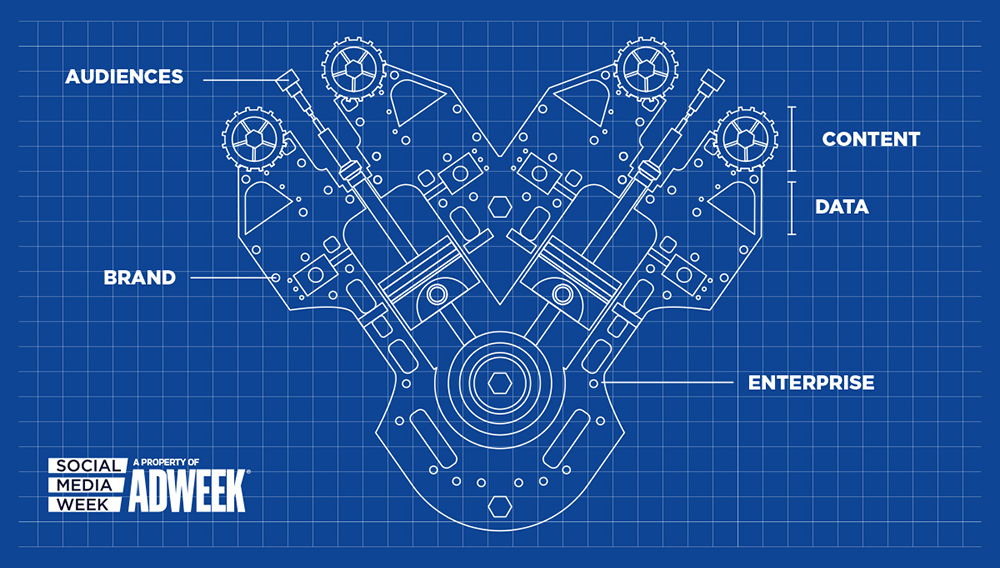
Brand and platform leaders, digital marketers, and social media practitioners came together at Social Media Week Los Angeles to unpack the 2021 theme of “Reinvention.”

RETAILER ROUNDUP
Countering COVID’s Domino Effect
The pandemic’s impact on chip supplies has caused seismic shifts in inventories, but retailers are meeting these challenges with customary toughness and ingenuity.
COMPILED BY NANCY KLOSEK

Dealerscope: How is the global chip supply shortage situation tracking these days relating to the consumer electronics and/or major appliances product categories? Which categories are hardest hit? What is the most disruptive aspect of this situation: product supply or product pricing hikes (or something else)? When do you expect the situation to improve — later this year, or not till 2022?


Jon Abt | Co-President, Abt Electronics & Appliances, Glenview, IL:
It is getting rougher. Seems like each day, we hear news of it affecting a new product segment. Of course, it’s expected in consumer electronics like computers or smartphones. But now it’s causing shortages in everything from microwaves to dishwashers. So many appliances today are smart — there’s a computer chip in just about everything. Unfortunately, there’s no indication that it will improve any time soon. We’re hoping the constraints ease sometime this year, but info coming in keeps changing.
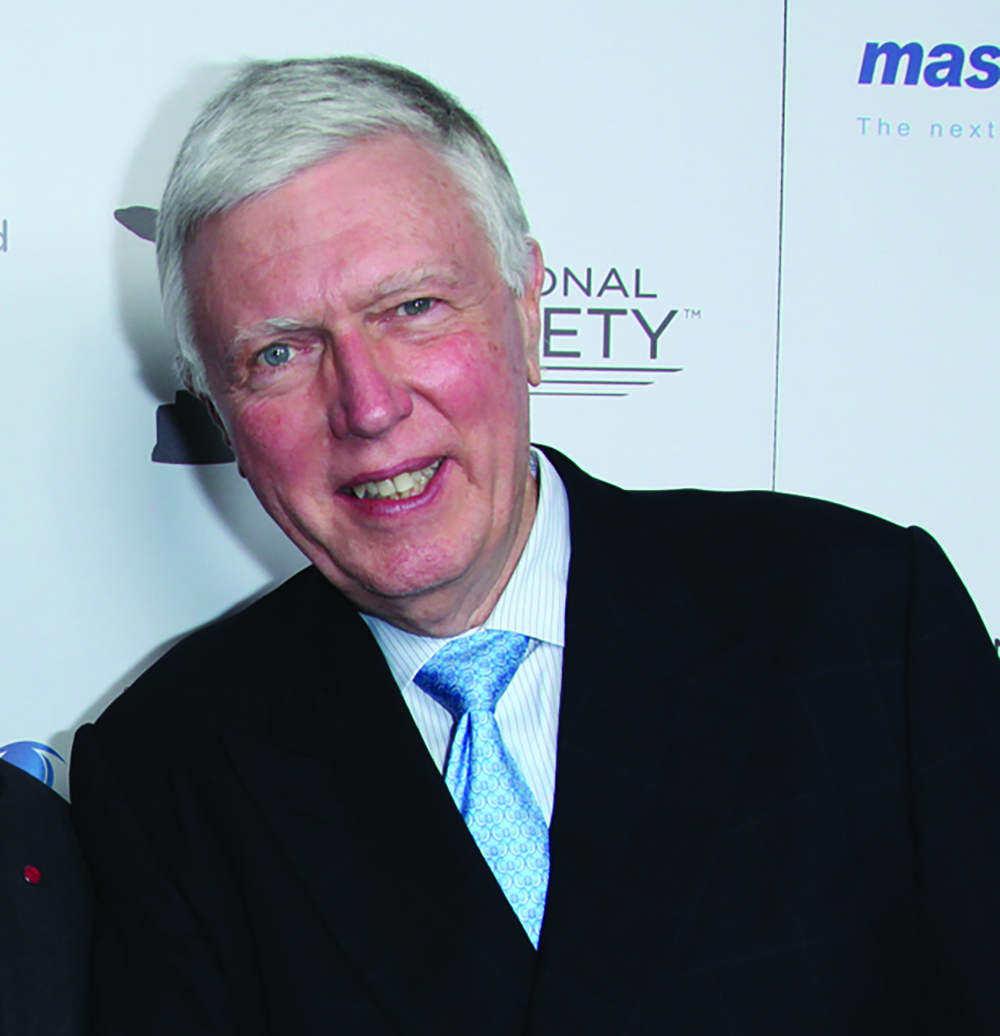

Tom Campbell | Chief Technologist, Video and Audio Center, Santa Monica, CA:
There are a number of issues at play. When COVID first hit, our founder, Joseph Akhtarzad, thought there might develop a huge pent-up demand. So he opened up additional warehouses and we stocked up very heavily. So that’s helped us. But there have been shortages, for a couple of reasons. One is the demand on the chips – the automotive industry, as you know, uses a lot of chips. And sales of TVs and appliances have been way beyond expectations. So demand has driven chip prices up. And that’s affecting more of the entry-level products. Another thing is that we’ve been told that docks operations are looking for workers – there’s a shortage. In Long Beach [Calif.], at the ports, the containers have been stacked up sky high. So it’s not just the making of the products but it’s also getting them delivered. That’s been another challenge. So we’re telling people they should really be buying now, because we think prices will continue to go up for at least another year, at least until the chip shortages abate. There are more chip factories opening up to try getting ahead of the curve but it can’t be done overnight. We are getting product, but it’s a challenge.


Bob Cole | Founder/CEO, World Wide Stereo, Montgomeryville, PA:
The chip shortage is a drag. To some degree, it affects us with receivers… Preamplifiers and music streamers were also affected.
A lot of it has to do with supply and demand, and the demand is so high, they can’t keep the supply up. My biggest concern is that it hinders innovation; they’re so busy trying to fill orders with the current stuff, there’s been a slowdown in new, innovative products, in my opinion. But then again, [vendors] find better, more efficient ways to manufacture.
COVID is a very big piece of [what’s coloring] this demand. On some level, the bar is lower – [consumers have been] almost used to not getting what they want [due to backorders and shortages], especially at the beginning. It was really hard to get product, and everything was slow. People may have wanted a particular product, but we didn’t have it and they asked, ‘Well, what do you have?’ and they bought it. In many cases, that was great for us, because we sold a lot of stuff on hand. Someone wants to spend $500 or $600 for a receiver, and you don’t have anything under $1,000 — and they take it.
I think [supply] will be better by the holidays, or maybe not till next year. I believe demand will continue to be very high — it hasn’t been high like this since the ’80s.


Eden Goldberg | Vice President, Marketing & Business Development,
InMotion Entertainment Group, Las Vegas, NV:
We are seeing some product launch delays in terms of supply, and a couple of partners have spoken of possible price increases.


Eddie Maloney | President, Cowboy Maloney’s, Jackson, MS:
It’s affecting both CE and appliances. Everybody sees it, and knows there’s a shortage of product. We have people come in, and they say that some places they’ve gone, they didn’t have anything to sell. These are big boxes. The chip shortages affect a lot of things. Even though most of your major [appliance] brands are made in the U.S., they depend on chips and parts from all over the world, and when that supply is hurt, they get hurt.
One thing that’s changed for us [with buying] is that we don’t call up and ask for a specific model; we call up and ask for categories. And when product categories become available, we purchase them, even though we may already have a decent supply. At least in the last 14 or 15 months, we’ve been taking most everything the manufacturers have. There are some positive sides to it, as far as our company goes — and probably for a lot of other mid-sized retailers. Your big-box stores are focusing more on [allocating for] their bigger locations — not on Mississippi… So we’ve been very fortunate to be able to have more inventory for sale than the big boxes. The other thing is, with manufacturers having a hard time supplying merchandise and the big boxes having a hard time [getting] merchandise, we’ve seen a stabilization on pricing — nobody’s out there promoting the deep discounts which our industry is known for, because there’s no reason to discount things you can’t get [enough of]. If I can deliver it today, and they can’t deliver it for two months, I don’t care what they’re selling it for…
I’ve been in this business, now, for 50 years, and at Cowboy Maloney’s, next year will be our 70th year. As for the last 18 months, I’ve never seen anything like this, ever. But it looks like it’s getting better; there are signs of that, after its having started in April or May a year ago. But I think it will be 2022 before things catch up… We’ve always advertised models and price, but now, we’re advertising that we have inventory. We’re advertising our terms and that we’re getting inventory every day, but we can’t go specific on products, because by the time the customer comes in, we may be out of it.
It’s more broad promotion.
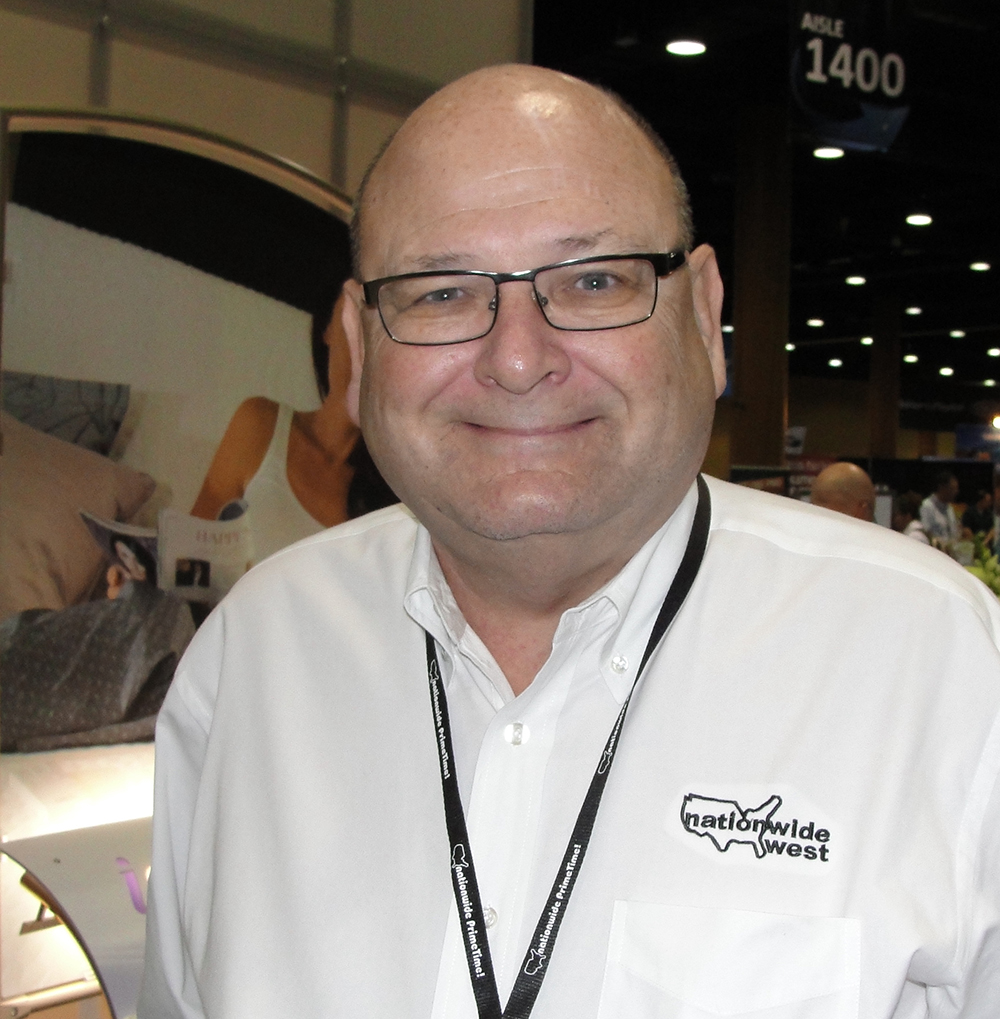

Ron Romero | Owner, Schaefer’s TV & Appliance, Lincoln, NE:
The chip shortage has just devastated the appliance industry with availability. We have so many products on backorder. I had a semi truckload of washers ordered for some time and I was told they’re sitting here, ready to go, as soon as they find the chips to put into them. That’s just one example. Everywhere I turn, most of our products, be they electronics or appliances, have some sort of chip issue. We have an appliance repair department, so to compound that, is parts availability — we’re struggling to get parts. If someone bought a washer six months ago and their control board goes out, we’re having a heck of a time finding one.
We have been getting stuff in, but not nearly what we need. Personally, I think it will take well into next year [to resolve], and I don’t know what it will take for [chip] manufacturers to gear up; they make semiconductors for so many industries, so who will get priority? Couple that with anything we’re buying from overseas in containers is slowing up, because of the containers shortage and a backup at the ports. It’s been a struggle. For independents like us, we’re doing what we can to buy what we can and are trying what we can. The technologies today lean so heavily on microchips that everyone’s being affected. It could be a low-end appliance to a high-end one. Compound that with the backup at the ports, and it’s really a juggling act.
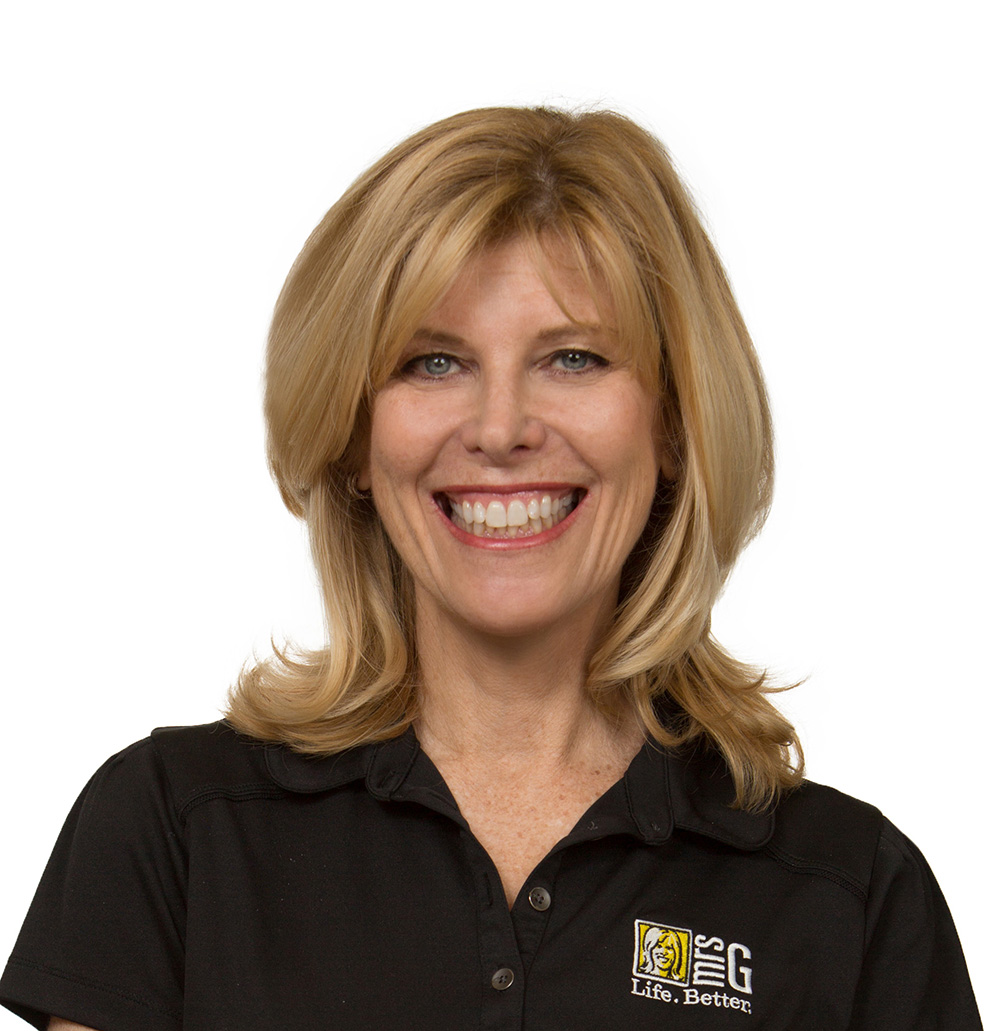

Debbie Schaeffer | CEO, Mrs. G Appliances, Lawrence Township, NJ:
We don’t usually talk about [appliance] chip shortages in our industry, but I wrote a blog recently that sums it up. I call it the perfect storm — delays in the production lines, delays in parts, the containers shortage – I am hearing more about the container shortage than the chip shortage. Not only container shortages, but the cost of containers has just skyrocketed. And as for what did get into containers, there’s more time spent waiting to get it into the ports. It’s a domino effect, and it’s still ongoing. Honestly, it may still get a little worse as demand increases due to consumers’ pent-up purchasing desires. People are realizing there is a shortage; before, consumers didn’t, and they’re thinking, ‘My washer hasn’t been working really well and normally, I’d wait till it dies, but I’ve heard about shortages, so I’d better order it now in case it won’t be available when I need it.’ It’s almost like a pre-replacement-cycle purchase. If your washer goes, you would normally replace it in a day or two. How can you do that if you want a particular model and size — and especially, if you want a washer/dryer pair that matches? My blog recommends that consumers become knowledgeable about what’s going on, do their research early, and make those decisions, and not wait till the last minute. It’s the same for the kitchen as for the laundry room. We don’t know how long this will go on. It has been a challenge knowing when products will be available; it’s across brands and categories of products.


Aaron Sholtis | CEO, HiDEF Lifestyle, Harrisburg, PA:
Product demand has been outpacing supply for all of 2021 in audio, furniture, and networking. Chip shortages are the primary factor in audio and networking, while demand and COVID restrictions are also factors.


Sam Yazdian | President, Electronic Express, Nashville, TN:
The chip shortage is affecting everyone in our category. Appliances have really been hit hardest. Computers and gaming products are affected as well, and right now, the ETA (estimated time of arrival) for some appliances is 2022.
Every aspect of business is affected — even small appliances like coffee makers. All of them have chip sets in them, and when manufacturers can’t get them, they can’t make the products. You can’t really put your finger on any one category. Then, there are the supply-chain issues, on top of chip shortages. Every product being imported is impacted because there aren’t enough truck drivers to bring them from the ports. For some products coming from overseas and China, there are not even containers available to load them into. Something is always affecting something else. It’s going to take some time for the supply chain to get back to normal. I think by mid-2022, hopefully, it will be resolved.







Dealerscope: Now that we seem to be moving into a post-COVID mode in the country, are you seeing any additional shifts in consumer purchasing behaviors – both in the types of products they are now gravitating to, and in their choice of how to shop for them (is there still a gravitation to online purchasing as opposed to coming into stores)?
Maloney: It’s amazing. We’re picking up a lot of customers now because we have had merchandise that other people haven’t. But the other area of our business that is just unbelievable is new-home construction and remodel. Those products are backed up months and months, because everybody hanging around their houses [during COVID] had decided they either wanted to move or re-do their kitchens. In certain product categories, we may be six months out [on availability]. And that’s never happened in my years in this business. Being a month out would be a long time in our business… I have people calling to order specific refrigerator models, and I can’t help them. But we have been very fortunate that our building and remodeling business [categories] have been great, and we’re doing probably a better job of getting merchandised than most, but we’re still behind, with a lot of merchandise still “on order.”
But you know, people are not spending money on travel, on restaurants, and not spending disposable income on things they’re used to spending it on — they have more money than in years, and also the government [stimulus] help. I have good friends in the car business and they’re having trouble keeping cars in stock. There is a lot of money out there. I hope and believe it’s getting better.
Romero: Buying has spiked online; we’re noticing [a spike] here locally as well. During the pandemic, people just didn’t want to go out and shop, so they went to online. We have an online chat set up, and that was pretty seamless. But now, compound that with availability issues, you really need to talk to the customer to find out what their real needs are so that you can see what you have that will work for them. You have to say what you have in the range of what they need. Online business during the pandemic helped, and honestly, our business was up during that time. So we didn’t see any downturn – in fact, we saw a spike. People were buying appliances and TVs and wanted to upgrade their kitchens and laundry rooms, and were cooking more, so were more apt to shop and buy, and that’s still the case. There’s pent-up demand, but we have just so many products. It’s very challenging.
We’re a heavily promotional company, so to put together a price-point ad is almost impossible, because you may not have enough of this or of that. So we have to get very creative on how we are promoting, and get away from promoting the price, and rather, promote the features, benefits and advantages of shopping with our company. Price-point advertising is on hold right now. Also, for example, in stock now, we have a good inventory of washers across brands. But when it comes to dryers, we’re limited. And that’s across the board as well. So to advertise a washer/dryer pair is really hard to do. We have a lot on backorder right now, and we do have a good inventory, but the mix is thrown off.
Schaeffer: No question [that there are shifts]. When COVID happened, everybody wanted a freezer – you couldn’t find one for the longest time because customers were all staying home, cooking more, and needed the extra food storage capability because they didn’t want to shop that often at the grocery store. For us, now, they are available, but what might be available to us may not be available in other parts of the country. What we’re seeing here [in Central New Jersey] is that people hadn’t been eating out or traveling, and had been saving their money during COVID. And a lot of these customers have a great deal of equity in their homes. With the lower interest rates available to them, they can pull out that equity and make improvements and renovations. They’re doing new kitchens, doing new laundry rooms, doing outdoor kitchens — and they’re letting workers back into their houses. A lot are coming in, in the last couple of months. During the height of COVID, it was all about replacement appliances. New construction stopped, the wholesale business slowed, but replacement business still went on. Now, there’s still replacement, but I feel that because of pent-up feelings and extra available savings, people are spending. They are re-doing kitchens, laundry rooms — and even fixing up a really nice home office. Under-counter refrigerators, coffee-making systems and microwave drawers are going into those home offices.
By replacing a four-piece appliances package in a kitchen without even replacing the cabinets or countertops sometimes makes the kitchen look brand new. I always tell people to wait a bit before considering changing countertops and cabinets until you do the appliances.
Campbell: To some degree there are shifts. Streaming is red hot. And because of that, consumers now want the bigger TV screens. And even though prices have gone up in some instances, you can still get an 85-inch television now for a very reasonable price, where before you had to spend anywhere from $12,000 to $15,000. The other thing is features – sets are edge-to-edge pictures, almost without a bezel, and speakers are built into the screen, or you use a soundbar. So you can put a 75-inch in the same space were you had a 65-inch — the starting sizes for the main viewing areas in the home are becoming larger than ever for buyers.
Yazdian: It works both ways. Customers shop digitally online, and if you have the merchandise they pick it up or it’s delivered. Now people have been buying the larger TVs during the pandemic because they are home and want a better viewing experience. For the time being, that should continue. To see when behaviors will be back to normal, it may depend upon the part of the country you are looking at, and the degree to which people are vaccinated in each area, and when things open up. It all depends on the industry you’re in; working from home is great for some industries, and not for others.
In our brick-and-mortar business, we’ve seen the traffic pick up. We keep promoting buy online, pick up in store (BOPUS). If they don’t want to pick it up, we deliver. I think this trend will continue because of the ease of the shopping experience, like for smaller items that they can buy online, and it is a way around having to pick up certain merchandise. If it’s a larger item, they will probably come to the brick-and-mortar stores. We have customers that go online, do their homework, narrow down what they want, and when they come here, it’s a faster, easier transaction. A lot of it also depends, too, on what you have in stock.
Outdoor-related products have been really good [sellers] — things like outdoor speakers, because everyone’s been confined to their homes. Also, things like projectors and outdoor screens have done well, for movie nights with neighbors, and also grilles and things like that.
Sholtis: Store traffic is up, but online and installation are far eclipsing retail sales. All products for the home are selling extremely fast — especially theater, audio, networking, and office furniture. We expect light commercial to pick up in the third and fourth quarters, as people continue to return to their offices, etc.
Cole: Some things occurred with COVID. People learned how to be Millennials – learned how to buy online, which was great for ecommerce, which is really the velocity of our industry these days. The other part is, people my age also realized the frustrations of buying online.
People were digging into their homes and realizing they needed a better network, which accounted for a huge rise in our business. They were staying home, weren’t going out to dinner or on vacation, so their budget was higher and it was almost, ‘I don’t care what it costs.’ And there was always a sense of urgency, which was a problem – ‘I want that theater next week.’
What else happened was that people discovered that being at home with family can be pretty nice. The whole ‘man cave’ thing — I hate that term — evaporated, and it became about the family. It was one reason we’ve been so successful.
I think that’s a COVID triumph. And I don’t see that going away that quickly.
I feel good about that — and it was one of the factors I’d been looking at very closely this year. Two years ago wasn’t the best year for World Wide Stereo [due to Amazon]. But last year, when COVID hit, business went through the roof. Even when we closed the stores for six weeks, I had four retail sales staff who refused to be furloughed; they said we’ll just call people. And they did Christmas numbers. And people were thrilled when they got the call, for the most part – a common response. They perceived the call as thoughtful – ‘Indeed, I can do with two more TVs, and the kids are home and we need a better network…’ It was a shopping list.
With our online chat, one of our guys handling that averaged $20,000 in sales a day, on his day off, just chatting and working his phone. In fact, one of his customers who wanted a TV and asked how to make it sound better ended up buying a $120,000 theater — [sold] on his phone, from a chair. There was that discovery, you know.
People always just want an excuse to buy a Ferrari, if they can possibly afford it — that’s what I always tell my sales guys. But in lieu of a Ferrari, make them feel like they’re buying a Ferrari!
ABT: People continue to buy in record numbers. Early on in the pandemic, there was a dramatic spike in the obvious categories: technology for working from home, bread makers, air purifiers. But in the last 12 months, we’ve seen increases in almost every product category. Appliances continued to perform well over the summer. And we’re now seeing a nice lift in categories that were all but decimated last year, like luggage.
And in-store shopping is more or less back to pre-pandemic levels. With Illinois now fully opened, we’ve restarted many of the in-store experiences that were closed all last year. Cooking demos, fresh-baked chocolate chip cookies on the weekends, interactive displays for kids, things like that.
Goldberg: Thankfully, there is a strong desire for travel, and the airports and resorts are bustling. We are catering more to leisure travelers as well as travelers’ intent to work from anywhere. The needs have evolved and the solutions we provide are therefore adjusted. We are always intent on being a solution for any traveler, and now we offer bundled solutions customized for each traveler.







Dealerscope: Which aspects of the business booms that manifested themselves due to working-from-home behaviors during COVID will continue past the COVID crisis (i.e., increased large screen TV sales, etc.)? Which do you think won’t continue?
Cole: I do believe this will continue — 2020 was up significantly over 2019. We’re busy in all categories, online. And in our custom integration business, we’re [very busy and] telling people we can’t install their system till September. But what we’ve noticed is that people, rather than running out and trying to find someone else not as good, are happy to wait for a premium experience. I don’t see that going away — nor do I see any of this boost in business going away before maybe next spring, if it ever goes away.
ABT: We believe that appliances will continue to flourish. Home gym sales are still strong. I don’t think that everyone wants to go back to the gym yet, whether for safety issues or because they’ve come to prefer the convenience of working out at home. Home office continues to be strong, as WFH [working from home] has become a permanent option for many. One notable slowdown is freezers. I don’t think consumers are worried that they need to hoard food anymore.
Sholtis: We expect that purchases for staycations and improving home networks will continue to grow, long term. Online and custom installation will continue to be strong as well. TVs over 80 inches will continue to be our biggest seller, but we don’t believe they will continue to grow past that size. Renewed interest in projectors and especially short-throw projectors will continue into 2022 and beyond.







Dealerscope: Do you expect the stay-at-home work habits could revert to pre-COVID work patterns/habits? Or will it be a mix of the two, as something unique and born out of the “new normal”?
Maloney: I think it will be a mix. We’re looking forward to having our [buying group] meeting in September… everybody wants to get back out and see people and talk to them, and network with other members and find out what’s going on with them, but it could be a lot more online meetings.
Sholtis: We believe it will certainly be a mix of the two. Someone wise said that major events in society, like COVID, typically don’t change the trends in commerce, they only accelerate them. Working remotely was a trend well before COVID hit, and I expect it was only exaggerated by the effects of the pandemic. Businesses and employees have learned, adapted and have become comfortable with the new normal of working remotely when possible.
Yazdian: I think these behaviors will continue this year, supported by stimulus money and tax credits consumers are getting. Then it will go back to more normal behaviors in late 2021 and early 2022. They are doing financing, but at some point, they will exhaust these avenues. People have been reinvesting in their homes. That’s one of the reasons major appliances and TVs are selling so well — and also part of the reason for some backorder situations. It’s been a bit of a domino effect. Also, there are a lot of new homes being built in our area, and new apartments – and hopefully, whoever moves there will want to buy a TV.
Cole: We have changed the way we do business. And a lot of other dealers have changed how they do business. Some dealers just ramped up for the higher velocity, but there are other dealers — and I count myself as one of them — who changed how they do business altogether. All of a sudden, my in-store folks realized the value of being outside — and the showroom has become less relevant as a general selling agent, but more relevant for higher-end equipment. It’s evolved.
The other thing [born of this situation] is hybrid operation. We have people who are very effective working from home. Now that COVID is ending we have people who still want to work from home maybe three or four days a week. Right now, in fact, I have an installer working on a major job who has the racks for the job in his house.
We had been doing site visits. Now, we will sometimes FaceTime the customer who will walk around the house and show us what the home looks like, and where things could go. Not only does it save long car drives; it’s an hour-long experience, and the customer feels very engaged — the customer feels more responsible. Some are still doing that. It’s not true of everybody, but it was true of many.
Goldberg: A hybrid of work styles will be the new normal.
Schaeffer: It will probably be a mix. I have customer service and IT employees who have been working from home, and have asked them to come back. We set them up and they did a great job working from home, but we miss them for that one extra step — of getting on the phone, making that call, sending that email — of having that relationship when they’re in the store. For me, I find it difficult to be in front of a small screen. It’s one thing, to be typing and writing, but to talk to somebody on a screen is difficult.
Our online business did go up during COVID, but online business with appliances is challenging anyway. Even pre-COVID, most online still has to be followed up with a phone call to ask certain questions. If customers buy a refrigerator online, you can’t just assume that it’s going to fit. A lot of customers don’t know exactly what to measure, and even though they place an order online for that, or for an over-the-range microwave, we really don’t process that payment until after we’ve spoken directly to the customer and asked a few questions to make sure that they’ve addressed all the right points and that that’s the right product for them. I would think most dealers would want to ask these questions.
Qualifying the customer is so important. And that’s the wonderful thing about a small, independent business like us. We’re extremely knowledgeable about those things, and because we are, we don’t have a lot of returns. It’s follow-through, and high-touch retailing.
Campbell: There are people who are looking forward to returning to the social interaction of working in an office, and others who do prefer working at home. But there’s no question that the TV today is essential – for security, home office, streaming, social networking, gaming. It’s beyond entertainment; it’s an essential communications device. And the world won’t go back to what it used to be. Some people have two or three jobs and for them, it’s about maximizing their at-home time.
Our Just One Touch custom installation division has been having another record year. More and more people are having us build home theaters, and adding things like movie theater chairs. And the smart appliances category, a newer one for us, is also doing well — refrigerators with interior cameras, washers and dryers can turn on or off automatically to take advantage of lower electrical power rates. What’s really selling through the roof, though, are the 4K and 8K smart TVs, with streaming being a huge component of that.
Abt: That will of course depend on where they work. Some will take a hybrid approach, and others will never return back to the office. So overall, I think mixed work habits will be a new normal. But I think most retailers will continue to work in-store.
Romero: I think that it will continue. People got used to working at home. It is the ‘new normal.’ I personally can do everything from my home office that I can do from my store office.







Dealerscope: Looking at the future, what is your business shaping up to be in 2022? Will it look similar to late-2019/early-2020 (pre-COVID) times, or will it turn into something completely unique, shaped by the challenges of COVID times?
Abt: 2021 will be another up year for our business. It won’t be as strong as 2020, but it will be up double digits. We’re not yet sure what will happen in 2022. We hope to continue strongly but it will really depend on the supply chain and other unforeseeable issues that may arise.
Campbell: We think that in 2022, consumers will continue looking for meaningful new technology. In TVs, it’s thinner, more beautiful screens, wall-mounted TVs, and with the newer 8K and 4K models, they can sit much closer to the sets for a crystal-clear viewing experience.
It’s a technology statement for them. And another thing – technology has become a statement of affluence for consumers. It used to be about what kind of clothes you wore; then it was about what kind of car you drove. Today, it’s about technology — what kind of smartphone you have… people notice that. And high-end TVs are the Rolls Royces.
Goldberg: We are experiencing strong sales across our stores and are fortunate to open new locations during this time, drawing immediate successes.
Maloney: In my opinion, I don’t think it will revert to exactly the way it was, but it will start getting back to the way it was. People interaction is still very important in most businesses, but especially in our business.
Romero: I think the way things are going now, next year will be pretty much the same, unless availability gets better – which it has to at some point. I know dealers who’ve decided to close their doors because they didn’t want to deal with this — smaller “mom-and-pops” who had successful businesses but were getting ready to retire anyhow and said enough’s enough… At this time, it’s a good idea to be diverse in what [brands] you carry.
Schaeffer: I think all of us [dealers] are having issues relating to the management of current inventory. When customers buy a four-piece appliance package, and we get the three pieces in but are still waiting for the fourth piece, customers don’t want it till it’s all available together — and all of a sudden, you’re in the storage business! We’ve never really been challenged by that before. We always knew we could get these pieces when we needed them, so we managed the timing of our inventory properly. We had it in when we needed it for the customer, and delivered it in a timely manner. Now, it’s for us to manage that to where you know you’re going to get it, and then being able to match it to when that customer needs it. It is a real challenge. Customers aren’t in the storage business, either.
And here’s the tricky part: we need to get it out of the warehouse, the customer’s not ready for it, they want to put it in the garage. We need to open those pieces and make sure there are no damages at that time; you can’t open it up a month later and see the damage then. Especially for the single-store retailer with a decent-sized warehouse, managing sold inventory [is a real challenge]. How do you do that? Do you need to make three deliveries to the customer? It’s complicated.
Sholtis: I believe it will be completely different only in that the world stimulus packages will be playing out in economies. This is already affecting pricing and inflation in a major way. Demand will be cooled by rising prices and product supply will obviously rebound. We are expecting this to make 2022 a challenging year, as companies get aggressive trying to comp some of their best years on record financially.
Yazdian: Honestly, it depends on how far the stimulus money goes, how far the unemployment benefits extend. It has to stop at some point, when people are back to normal.
Plus, now that things are opening back up, you are competing with travel, and with the entertainment and sporting event categories, as people are getting back out — and also with restaurants. For a year and half, people didn’t travel and had more disposable income to spend on their homes. They didn’t go out to eat, or to concerts. They spent on their homes and on remodeling. That is what fueled all this until now. But now, will people need to remodel their kitchen again? Probably not. I think it will level off, because there are more choices opening up where they can spend their money.







Dealerscope: Is there anything we have not touched on that you’d care to comment on that would be specific about business initiatives or strategies you’re planning for the second half of 2021, and moving into 2022?
Campbell: We have a customer hotline they can call. People get “keystroke-itis,” with all the typing to research technology products. This way, they can interact with a live person and shop our store online and not have to touch a keyboard; you can talk to somebody on the phone and you can actually show them. We offer free setup on many of our sets as well, which most of the online companies can’t do. We’ve also been very pleased about the success of smart appliances. We stock and show refrigerators that are tied to the Internet, and of course, the smart washers and dryers.
Especially with COVID, people are more reliant than ever on technology in their everyday lives. The outlook is bright, and the challenge right now is getting enough chip-based product to meet the demand.
Cole: Lots of people have gotten more serious. ProSource during this time took the opportunity to really develop their ProSource University, for example. There’s more about becoming a lot more professional, and about things related to training, which I think was opportune, and I was really pleased with how many people responded to it, including us. I would have told you we have our own training initiatives, but it’s been a good thing. And [other groups are] making that same investment in professionalism.
A concern is manufacturers becoming conglomerates — there are advantages to that but also disadvantages. The thing that’s always wonderful about the free market is competition, and that can dilute it. So we’ll see what becomes of that.
One thing successful CEOs all have in common is being paranoid — never comfortable, and always thinking things are going to go to hell in a handcart. Over my forty-some years in this business, there were maybe five years of feeling comfortable. I feel that way now — comfortable, with our industry and with the business.
Maloney: We still have pretty much open orders with the manufacturers.
One interesting thing happened last March and April, when it was hard to get anything, and the trucking companies shut down, and the manufacturers shut down their plants; it was hard to get any merchandise from manufacturers. But we were able to sell over $1.5 million in distressed inventory — because people had to have it, even if it had a nick or a dent on it. And we had some things like that, and were able to move a great deal of distressed inventory then, which helped our profit and loss. We discounted the products but we didn’t have to discount it as much.
I’m very optimistic [for the rest of the year] because of the position we’re in right now. We’re focused on Mississippi, and our competitors are focused nationwide…
Romero: We’re planning on business as usual. We’re planning for growth; we’ve done things in our store – upgraded some of our big, massive displays, and are in the process of re-doing our Wolf/Sub-Zero department, and have upgraded several kitchens to better showcase products. We’re continuing to invest in our business; business won’t go away. There are shoppers out there, and you want to give them the best shopping experience that you can.
We closed our retail floor for two weeks right at the start of the pandemic but continued to operate online. This was when the mayor was telling everyone to stay home. During that time, we worked on putting protective Plexiglas up, and on sanitizing areas, and we remodeled a little bit.
We’re not putting our heads in the sand; this, too, will pass. We’re looking at it aggressively — and I’m excited about the future. There will be plenty of opportunities. We are getting products; my inventory is strong. When the pandemic started I was just in the midst of building on a warehouse, and I thought, oh my gosh, what am I doing? But I’m glad I did it because it’s full… It’s just a different way of doing business. We have the space to warehouse now, and lots of dealers don’t have that luxury.
Schaeffer: The key for us is to constantly promote and keep our brand trust solid.
That means, when a customer comes in and they want a particular model, we tell them they need to be patient right now – and, most important, we tell them we’re going to keep them in the loop, and then we keep them informed. They still want to hear from you, even if you don’t have any news about availability.
We’re seeing more people who we’ve told they may need to wait for their product, who have then gone to another store and been given a date for an order placed there, at the other store, and then that store misses the date — and then they come back to us to place the order… It builds on our trust with them.
Sholtis: We are extremely excited about the shift generationally in purchasing power as Gen Z enters the workforce and Millennials continue their prominence. I expect this will continue to change how we go to market and reach our audiences. Social shopping trends will be our main focus for the coming years..
Yazdian: We will keep promoting and maintaining the best customer service we can offer, to take share from the big-box stores. We also always review different categories to see what we can add to our mix. Our buyers are always looking and researching. We have to keep the customers we have, and with additional categories, hopefully by doing that, they’ll keep on visiting our stores more often, and keep our sales up. It’s also important to have step-up merchandise. For example, with the small appliances we sell, we are not trying to compete with Walmart or Target; we sell the step-up brands.
We are always optimistic. And last year, during COVID, we opened two new locations – one in Chattanooga in a former Toys R Us building, and then we opened an outlet store in Nashville’s Opry Mills Mall. And we are always looking for when an opportunity comes along.
RETAIL ON THE RUN
A Store Visit with Jimmy Garson, CEO of DataVision


INTERVIEW BY TOM SAMILJAN


We often have special deals. In that premium space, we’re often more competitive than bigger stores, because we’re buying that higher-end product in quantity.
What’s the history of DatavVision?
I’ve been in the consumer electronics and PC businesses for a long time. Before DatavVision, I ran a company called United Computer. We were one of the first Apple dealers and then launched the Next computer before Steve Jobs went back to Apple. Then, in 1990, I started DataVision, primarily as a mail-order catalog business, back when everything was thriving in the PC and consumer electronics businesses. For the first two years, before we opened our first retail store, we were catalog-based. We’re one of the first actual computer mail-order businesses, for both consumers and B2B. Then, in 1993, we opened our first flagship store on Fifth Avenue and 39th St. We advertised in Computer Shopper and other magazines, and customers would just call an 800 number to order what they needed.
We’ve always been a major part of the retail landscape in New York, but since we’ve been online since the start of the Web, a big part of the focus of our business is online sales. We’re authorized to sell all the major brands — Apple, Samsung, Sonos, to name a few — online. We also have a very strong B2B business, which has been our focus for the past five years. And then, over the past three years, we’ve built up a strong custom install business, which handles everything from small and medium businesses, to private homes. We do a lot of networking for the businesses, and our sweet spot is $3 million to $25 million homes. We also have a complete service center to service all the major PC brands. So we’re a jack of all trades.products from major brands, but we often have special deals. In that premium space, we’re often more competitive than bigger stores, because we’re buying that higher-end product in quantity.
How many stores do you have?
Right now, we have one store located on 38th St. in Manhattan. Our original store was a 35,000-square-foot showcase on the corner of Fifth Avenue and 39th St. It was three floors. It was like the Henri Bendel of computers. If you wanted an $8,000 IBM ThinkPad, we had it in stock. If you came in and said, ‘I want this, and I want Adobe Premiere and this specific configuration,’ we did it on the spot for you.
We moved out of our Fifth Avenue store about six years ago. Then we were on 23rd St. between Fifth and Sixth Avenues, then we moved back up to 38th St. because we ended up capturing more square footage for a big difference in terms of reduced rent. We were about to do a grand opening when corona hit, but now we’re looking to expand and take more space, now that rents are so cheap. We’re going to use the extra space to do local fulfillment, so we can stock more products in the city and do same-day fulfillment — an hour or two — anywhere in the city.
We’ve mostly always been online, and the one flagship store, though we did expand many years ago into Long Island, and we were looking to expand further than that, but we always knew that brick-and-mortar retail wasn’t the avenue to go. We’ve always really focused our business on B2B, custom install, and online sales. I could open 10 stores tomorrow, right? But I’m doing more online than most companies with 150 stores, so why do I need a storefront? I think not opening stores is one of the greatest things we ever did. We’re still in business after 31 years.


The odds are that if you walk into a Best Buy, it won’t have a product in stock, but if you go to my website, we’ll have it in stock. We try to make sure that everything that’s hard to get is in stock. That’s the key to the business right now. You have to have what people want.
In what ways is DataVision different from the competition?
We’ve always been very different in the New York landscape, and we’re still the only true computer store in the city. B&H is more like a pro video store that sells computers, for example, but the smart home means that everything has become so much more about computing and networking. A lot of times, these audio-video guys don’t know what they’re doing when they’re installing networks. Either they’re not configuring it the right way or they don’t have access to the right product — there are a lot of things that can go wrong with it. Right now, the network is super important. Internet providers all over the country are overwhelmed. You may be paying for 400Mbps bandwidth but you’re only getting 30. You want to make sure you have the right equipment.
We’ve always been very service-oriented. From a service standpoint, our quick turnaround is a big differentiator — we provide end-to-end solutions, everything from AV to networking to iPad rollouts to your employees. We work with Douglas Elliman, one of the largest real estate companies in the country. We work on its internal systems, but we also have a relationship with the 3,500 brokers it has. If they need service, we’ll send them a label and they’ll ship the product right back to us. How we can turn things around really differentiates us from the competition.
Also, I’d say [what’s also unique is] our access to A1 brands — we’re on par with Best Buy as far as the brands you can purchase, but we often have a bigger selection on-site, and, most important of all, we have items in stock. It spread itself so thin. Say you want to get a specific iPad. The odds are that if you walk into a Best Buy, it won’t have it, but if you go to my website, we’ll have it in stock. We try to make sure that everything that’s hard to get is in stock. That’s the key to the business right now. You have to have what people want.
What is DataVision’s e-commerce or omnichannel approach?
Right now, we’re obviously trying to sell everything everywhere, but the key is having the product. It’s the biggest game-changer, especially now, due to the chip shortages. There are shortages of audio, TVs, Apple products, gaming, monitors. I’ve been using my relationships to get as much merchandise as possible because the truth is, if you’ve got it, you’re gonna sell it. In addition to more local fulfillment, we have a warehouse in Philadelphia and another warehouse in California.
It’s also just about immediate demand, making omnichannel really deliver; it shouldn’t matter that you can’t go into the store.
Name three things that the management team at DataVision has implemented that you attribute to the success of the store.
Right now, people are afraid to come into any store, and I’d say the last thing a customer wants to do is sit in a store and wait for answers. So we make sure our sales team is very educated. Most of my salespeople have been with me for anywhere from 10 to 25 years. These are seasoned people; this is their livelihood; they know the product — and they know how to deal with a customer. Whereas at most department stores, the salespeople are part-time; it’s not a career to them. They’re clerks, not salespeople. If you want a clerk, you go to Whole Foods and ask, “Where are the canned tomatoes?” And then turnaround time is a big thing for us, along with having items in stock.
Andy Grove, the late, former CEO of Intel, once gave me the best advice. He said always invest in your company in the worst of times. And so every time there’s been a downturn, we have invested so that we are prepared for the upturn. Real estate prices have gone down over the past year, for example, so we’ve been able to expand our retail space to use for local fulfillment at a significantly reduced rent.
Right now, people are afraid to come into any store, and I’d say the last thing a customer wants to do is sit in a store and wait for answers. So we make sure our sales team is very educated. Most of my salespeople have been with me for anywhere from 10 to 25 years. These are seasoned
people; this is their livelihood; they know the product — and they know how to deal with a customer.
Did the pandemic affect how you do business in any way?
Not really, because we were already doing business the way we do it now. That said, the demand is just so much higher online than it was two years ago. It’s the same reason why Amazon and Walmart grew their businesses. I think for retail and shopping habits, what would have been five years from now is now. People that are buying online are not going to go back and buy in-store. Shopping habits have changed for good.
What are your goals this year?
Well, obviously, to do more business, make more money, drive more traffic. Online’s going to do what online’s going to do, so again, we are focusing on securing as much product as possible. And also on B2B. From a customer standpoint, we think there’s going to be a huge uptake in back-to-office sales. Come September, you’re going to see people’s offices spending money, upgrading the networks, and upgrading security. They’re going to be either downsizing or upsizing — either taking less space with a remote workforce or taking advantage of office space at 50 cents on the dollar.
Do you have any plans to expand in other ways or sell other categories?
Not really. Besides the extra retail space for local fulfillment centers, we’re looking to open more distribution centers around the country to meet demand quickly.
Is there anything in the building of your
business that did not go the way that you expected, and that you learned from?
Sometimes I wonder if I should have expanded more in terms of retail stores. We had plans to open 12 stores at one point. Whether I ultimately didn’t do it because I was concerned about my quality of life or because I wouldn’t have control doesn’t matter. Ultimately, I did the right thing in not expanding. All these other companies that expanded over the years — CompUSA, CircuitCity, Fry’s — never really had staying power. Either they expanded too quickly or made bad decisions. It’s hard to manage one store, much less 50. You have to be able to sleep at night. I really think the best thing we ever did was just focus on our core base, which is our online sales and service businesses.
Do you have a favorite section of the store?
I’d say the Apple department in the 38th St. store. Everything is very hands-on. You’re able to come in, see, and pick up and feel products. At a lot of department stores, you can’t lift an iPad off the cabinet, and if you can’t turn it around, you can’t get a good sense of a product.
Apple does a great job with product displays as well, but the difference with us is the service that we can offer. You don’t have to make an appointment with us or wait an hour to see someone at the Genius Bar. And you can buy other products and accessories along with that iPad. You can get a Sony Alpha camera and a big choice in SSD drives, for example.
APPLIANCES
Automating Convenience
How dealers can pull smart appliances
into the connected home.
BY GILES SUTTON, INTERIM CO-CEO OF CEDIA


If the smart appliance doesn’t work with the rest of the connected home, it’s not really smart.
The connected kitchen is catching on: As appliances become smarter, more consumers are seeking smart white goods that make life easier. By 2025, it’s expected that 11.6 percent of U.S. households will have some form of smart appliance, ranging from dishwashers to refrigerators and everything in between. Retailers are rising to meet the demand both online and in-store.
Despite this groundswell, a study by CEDIA, BSH Home Appliances Corporation (a company of the Bosch Group), and CE Pro revealed that 38 percent of custom integrators have not completed a single project involving smart appliances. While the majority of home technology pros want to integrate appliances into their product mix, learning to talk to consumers about how these products fit into the bigger “smart home” picture isn’t as simple as it might seem. A jumble of different options, inconsistent interoperability across devices, and varying control features can all make for a complicated conversation.
As more leading smart appliance brands like LG and Bosch enter the custom integration space, dealers and integrators must step into consumers’ shoes. They’ll need to take the time to understand what the customer is hoping to achieve with a smart appliance, other goals an appliance might impact, and which devices should be part of the same smart home network. With a complete picture, dealers and their integration partners can help their customers take full advantage of smart home appliance features and avoid a Tower of Babel in their networked device communications.
Understand the client’s existing set-up
The first step is to understand the client’s existing ecosystem and how new appliances can further enhance or complicate it. Smart devices connect more than just homes; they connect lifestyles and add simplicity to day-to-day tasks. In bringing smart appliances into the conversation, begin by investigating which technologies the client already has in place, which AI assistants they are already using, and what they hope to achieve with smart appliance technology. As with other smart home solutions, the interface and features of these appliances should be comfortable and consistent with the rest of the home.
If the homeowner is looking to add a smart appliance to a home without much tech beyond a voice assistant speaker, they might be open to a voice-activated fridge or washing machine that leverages the same cues and removes a lot of the intimidation out of taking on new technology. On the flip side, if a client has a fully integrated control system already in place, it’s important to offer the technology that will not only blend seamlessly into the ecosystem, but also enhance the convenience and function rather than detract from it.
The smart home is meant to make life easier, with each device easing the burden of everyday tasks. That said, smart appliances aren’t hitting their full potential if they can’t co-exist with the network that’s already in place. To ensure that clients are getting the most out of smart appliances, interoperability should be a consideration early in the process. If a customer needs a separate app to help manage the dryer, or if it’s not tied into the whole-home control system or voice assistant they’re using, chances are these new features won’t be very helpful to them. Really, whatever tasks the smart dryer is supposed to alleviate have just been replaced by the new task of having to download, learn, and manage a new software program.
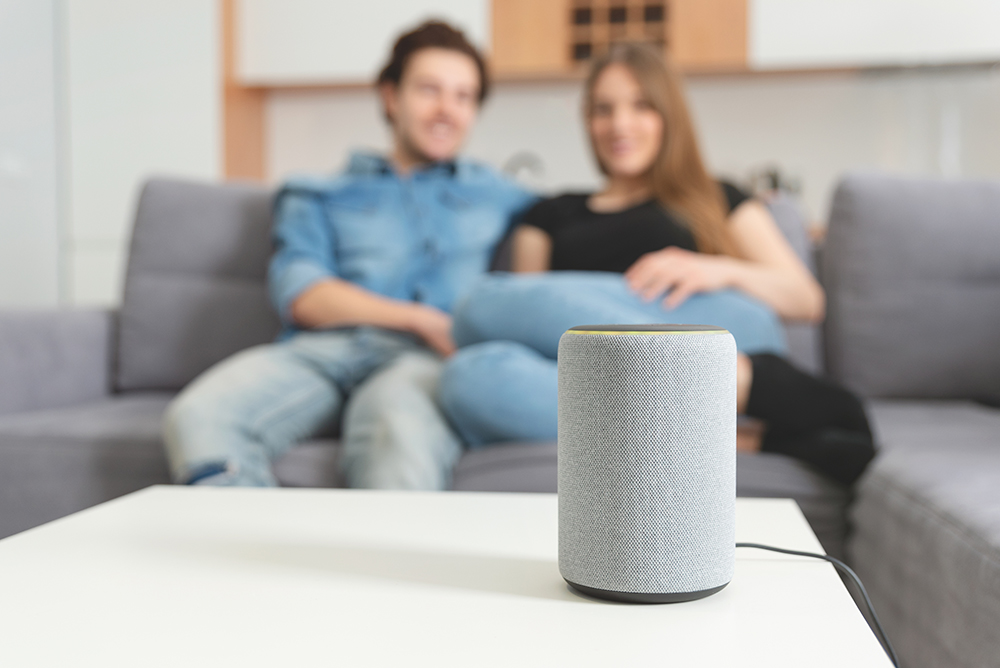

Focus on the right features
Outside of interoperability, features, and perks also need to be at the forefront of the conversation to make sure the appliances will deliver on what the homeowner is seeking. From mobile connectivity to remote-start the dishwasher, to smart mics that pick up voice commands from across the house, smart home devices should automate convenience. The right mix of features will depend on lifestyle: While some customers are interested in devices that prioritize safety sensors and remote control, others will want to prioritize efficiency. Some might even be seeking a bit of razzle-dazzle from a sleek, impressive device.
Dealers can turn whatever perks appeal to homeowners into selling points. For example, if the customer is interested in monitoring and managing their home energy consumption, then they need smart appliances that are capable of reporting such data. Major appliances are some of the biggest energy suckers in the home, so no home energy management portrait is complete without them. Ideally, the smart home manager should be able to send remote commands to optimize efficiency as well, running cycles at off-peak power consumption hours, for instance. Some AI assistants can even make lifestyle recommendations based on data for connected devices, letting customers know if they should consider changing temperature settings or cycle durations for certain appliances to help meet green-home goals.
These features aren’t merely virtuous; they demonstrate the literal value of smart appliances by quantifying utility savings over time. When offering a customer a smart appliance to meet green goals, always emphasize the financial savings as well. When making purchasing decisions, customers tend to value both environmental and cost considerations, but prioritize the latter. By offering smart appliances with eco modes, remote control, scheduled start, and other means of energy management, dealers can give customers the best of both worlds.
Reduce the learning curve for the customer
Some users will be driven more by pure convenience. In this case, the dealer and integrator must understand the existing device ecosystem well and ensure interoperability. They should also strive to limit behavior changes required from the customer. In the best cases, once the smart device is fully set up, it becomes proactive, giving the user suggestions and notifications through communication channels that the customer is already using. However, getting over that initial setup hurdle can be daunting. Bundling the appliance with setup services can not only increase the margin on the sale, but also improve the customer’s satisfaction with the purchase. As a bonus, it also gives the dealer insight into the customer’s smart home ecosystem, increasing opportunities for future sales.
Smart appliances will only continue to find their way into connected home conversations: From asking the fridge for a head count on grocery items to telling the oven to preheat to 350 degrees when elbow deep in a turkey on Thanksgiving, smart appliances offer a unique advantage to the connected home ecosystem. Integrating them into the holistic home system can greatly enhance the user experience. Dealers and integrators should be prepared to start the conversation about which devices are the best fit for any consumer’s lifestyle.
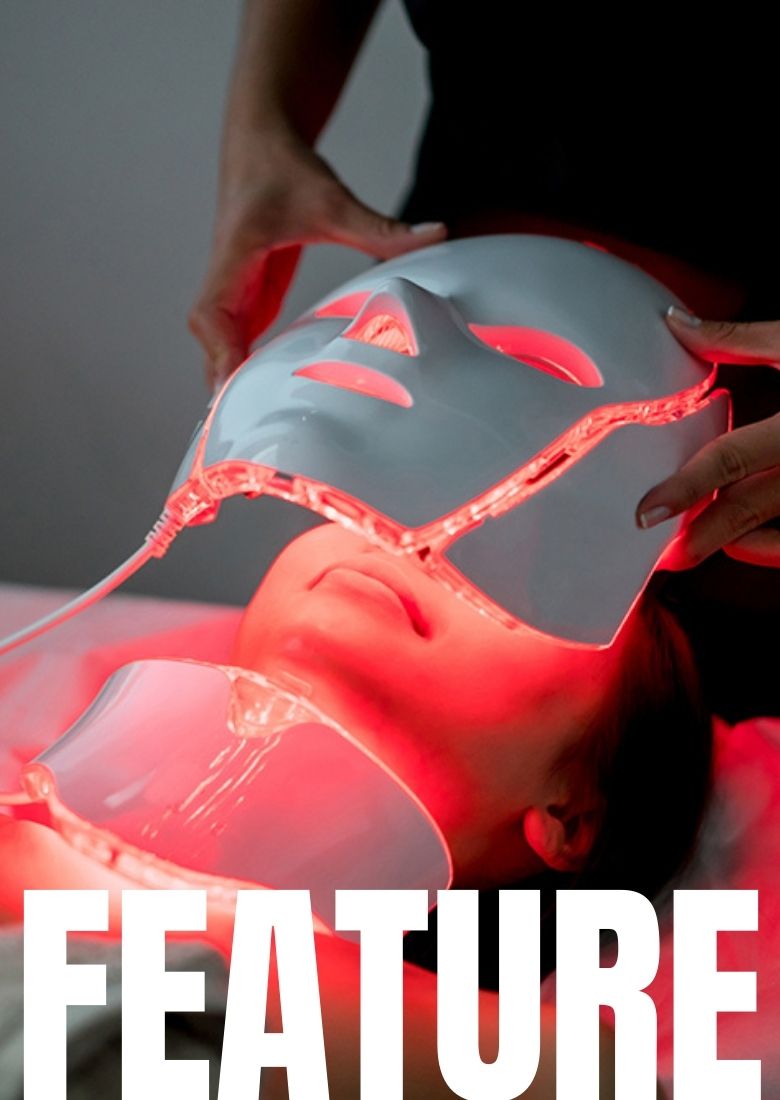

HEALTH & WELLNESS
How Skincare Embraced Tech The Way Cosmetics Never Could
Generation Z has delved into skincare, bringing new opportunities for tech to infiltrate the beauty world.
BY JESSICA GUYON
The once steady cosmetics industry has been experiencing a downturn this past year — and, surprisingly, COVID is not the only one to blame.
Piper Sandler, which conducts a semi-annual survey of U.S. teens, found that Generation Z consumers have been spending far less money on cosmetics than their Millennial counterparts. Instead, the Spring 2021 survey found that this group has become increasingly invested in skincare — so much so, that its spending in the category has surpassed makeup spending.
Before the rise in skincare, tech didn’t have much of a place in the beauty world. In fact, it was probably one of the few categories that had very little of it. But skincare has opened up a world of opportunity for tech that lipsticks and mascara just couldn’t.
For starters, skincare seems to have significantly more product categories than makeup, and it has people curious as to whether or not the latest gadget will work for them. Driving that interest is social media and the influencers who openly share their skincare routines with their viewers.
The Piper Sandler survey found that TikTok influencers have significantly reshaped skincare brand preferences, with 86 percent of females using online influencers as a source of discovery for beauty brands and trends. While much of the category consists of topical creams, lotions, and serums, there are a growing number of tech products capable of achieving skincare benefits that were previously only available in a salon setting.
The skincare influencers holding the top spots in social media hierarchy don’t limit themselves to only reviewing beauty tech gadgets. However, reviews and tutorials on these products are well mixed into their content.
Hyram Yarbo, also known as @skincarebyhyram, often critiques his viewers’ skincare routines on TikTok to offer advice and opinions on which products they should keep and which ones they should consider removing. One of these videos showed a woman using a variety of beauty tech gadgets like a facial steamer, a pore vacuum, and a high-frequency acne wand. Yarbo touted the use of the high-frequency acne wand in particular, pointed out the minimal benefits of the facial steamer, and recommended a topical product in place of the pore vacuum to combat blackheads.
Other influencers such as Dr. Shah and Dr. Maxfield, both dermatologist and dermatology resident physicians and creators behind the Doctorly YouTube channel, will often dive deep into one specific beauty tech category. The pair’s video from December 2020 took a close look at microcurrent devices, which send microcurrents of electricity to the skin to subtly lift and firm the face. But, as Dr. Shah explained in the video, more research and development are needed in this field, even though the potential is there.
“We need double-blinded randomized controlled trials to evaluate these devices,” says Dr. Shah in the video. “Here’s how it’s done: Non-working devices are used on the control group and then real devices are used on the treatment group. Next, an independent reviewer that does not know which device was used evaluates the subjects. Unfortunately, when the person evaluating the results knows which subject was treated or which side of the face was treated, this leads to inherent bias and is a much weaker form of investigation.”
Another important factor to keep in mind is that everyone’s skin is different, and the products that work for one person may not work for another. But as long as the manufacturers of these skincare gadgets continue to make bold claims of anti-aging, acne-fighting, and skin rejuvenation, consumers will continue to come back for more.


HEALTH & WELLNESS
Five Devices Using Tech To Take Skincare To The Next Level
BY JESSICA GUYON
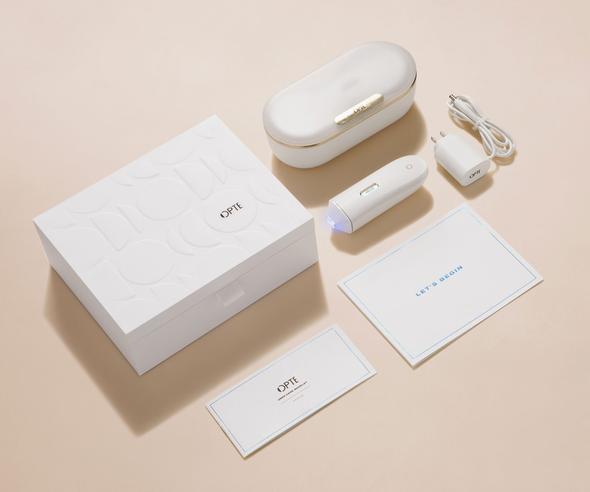

1. OPTE Precision System
The OPTE Precision Skincare System treats hyperpigmentation, dark spots, sunspots, age spots, and more through a high-speed camera that scans skin and detects uneven tone. Trouble spots then receive an Optimizing Serum that instantly corrects dark spots and fades them over time.


2. Dermaflash Luxe
The Dermaflash Luxe powered by Sonic Edge Technology is similar to a razor and works to remove layers of dead skin cells, dull built-up debris, and peach fuzz. Two-speed levels combat these issues with precision and safety to achieve a more even texture and tone.


3. NuFACE Trinity (Main Image)
The FDA-cleared device includes three attachments for tightening lines and wrinkles around the eyes, lips, and forehead. The technology behind the 3-in-1 gadget includes both red light therapy and microcurrent facial toning to target different needs of the face.
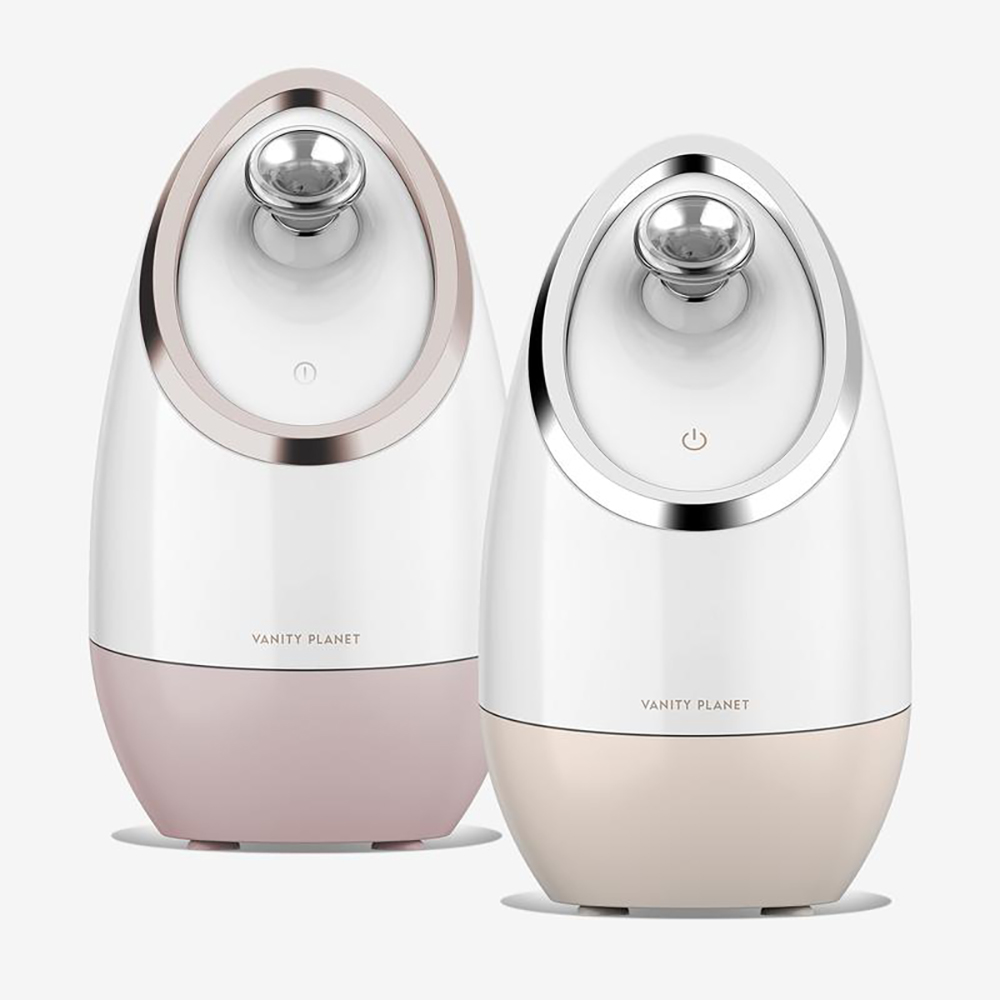

4. Vanity Planet Aira
This ionic facial steamer claims to clear pores and stimulate circulation in a manner previously only achieved by professionals. The “personal sauna” uses nano-sized water molecules to hydrate and soften the skin’s surface and detoxify pores of impurities and dead skin cells.
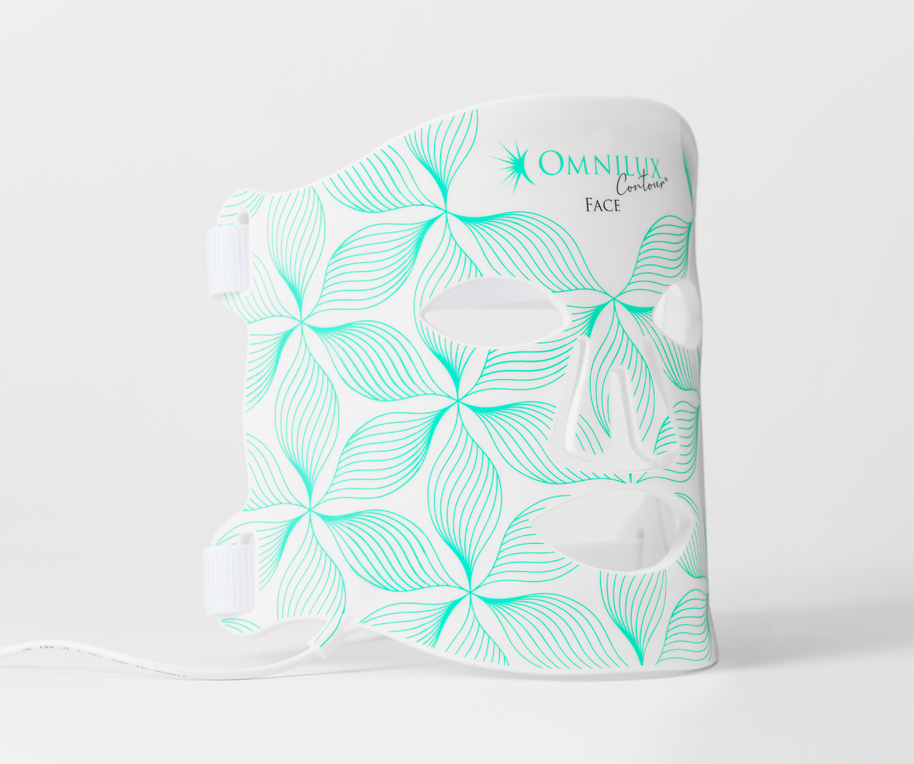

5. Omnilux Contour FACE
This FDA-cleared, dermatologist-recommended light-therapy mask has been clinically proven to reduce fine lines and wrinkles, reduce the appearance of pigmentation and redness, and promote healthier, younger-looking skin. The mask is intended to be used three to five times per week for 10 minutes with results appearing in four to six weeks.
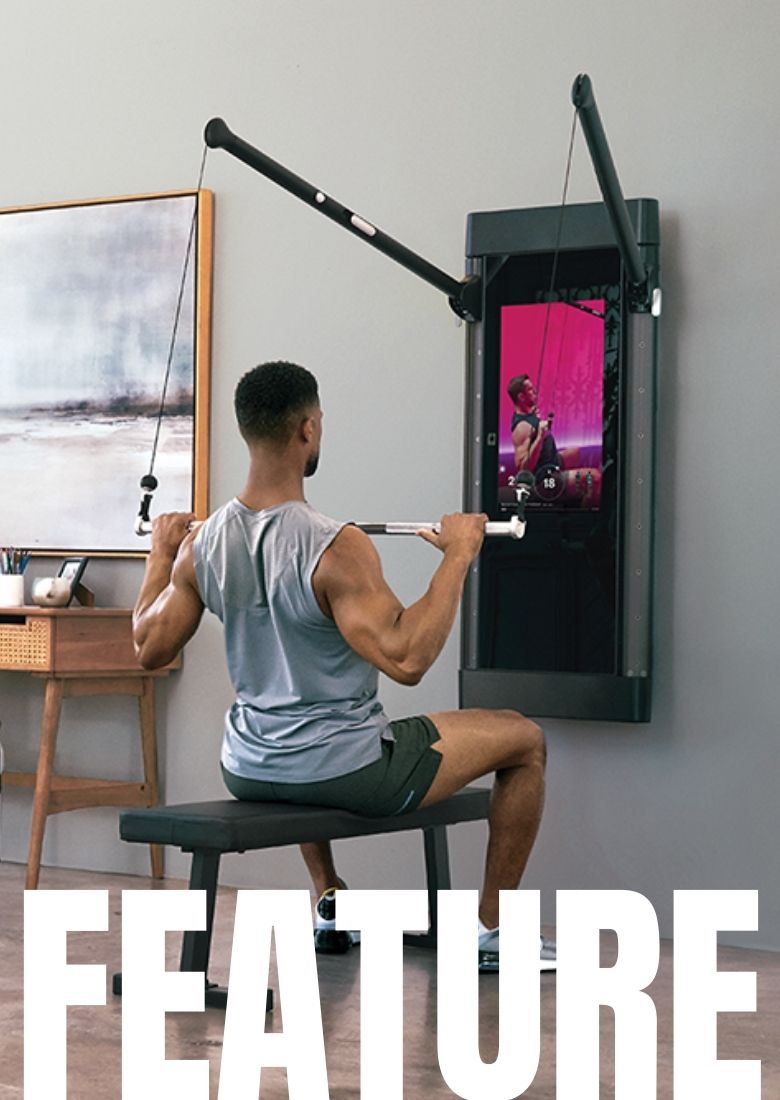

HEALTH & WELLNESS
Getting Personal
The pandemic was a boon to the health gadget sector, leading more consumers to take an active role in managing wellness at home and on the go.
BY STEPHANIE ADAMOW


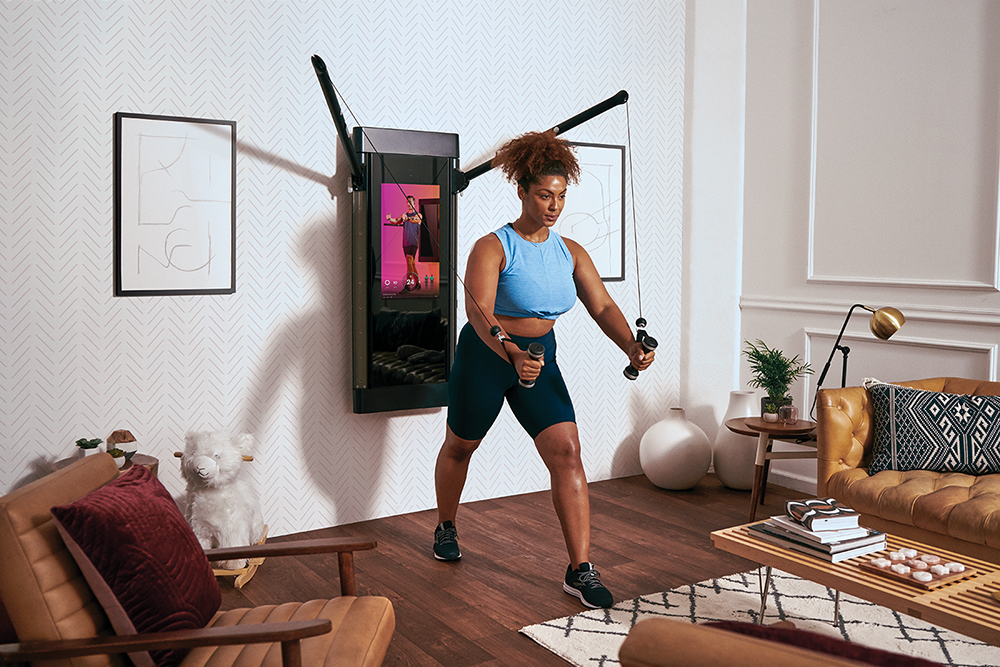

Tonal’s primary users are longtime fitness enthusiasts who are motivated, disciplined, and looking to improve their fitness with better workouts.
There is no question that consumers have a greater interest and are taking a more proactive role in managing their health and well-being. While we all are experiencing pandemic fatigue, COVID-19 has played a part in accelerating this trend.
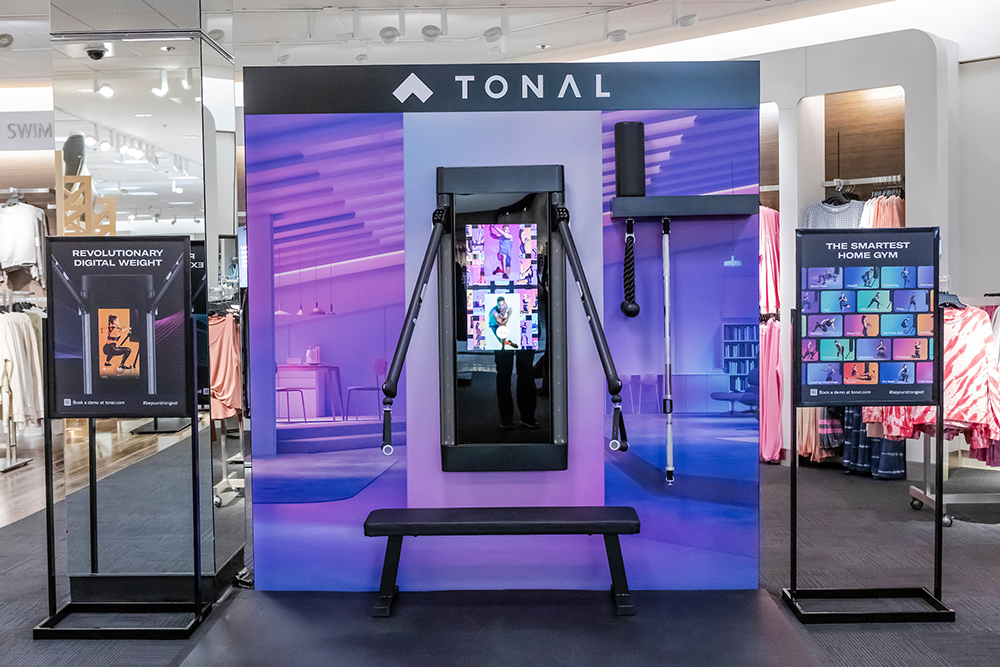

Tonal recently partnered with Nordstrom to reach its target customers face to face.
Connected Health Awareness Increases
According to Parks Associates’ “Analyst Insight: Consumer Trends in Telecare and Connected Health,” released during the research firm’s Connected Health Summit in June, there has been a massive increase in technology adoption across the healthcare spectrum, including among consumers and clinicians. Remote health consultations, done via video, voice, or text, have grown considerably from Q2 2019, with only 15 percent of U.S. broadband households (5,000 surveyed) utilizing these tools, to 64 percent in Q2 2021.
“The use of electric devices has skyrocketed,” reported Kristen Hanich, senior analyst for Parks Associates. “Technology is now perceived as a valuable tool as opposed to a threat.”
This is reflected in the data, as Parks Associates reports that 55 percent of surveyed consumers “own an Internet-connected health or fitness device that captures biometric data.” Users cited several uses for these devices, including chronic condition monitoring, telehealth diagnostic support, independent living, and fitness support.
The trend of user-controlled health monitoring has been growing over the last few years, said Jan Vitrofsky, founder of HEDsouth, a tech integration company that provides clients with planned solutions involving entertainment, health and wellness, lighting, shades, and smart home control.
“Over the past couple of years, consumers have become much more aware and invested in their health and well-being, and are tapping into whatever tools and devices are available to enhance their wellness,” noted Vitrofsky. “For example, they have seen Apple provide smart device standard settings for warm light tones and cooler light tones for better sleep and productivity. And people now understand that smart apps can monitor sleep, temperature, heart rate, and more. We’re seeing these trends in consumer understanding, both inside and outside the home.” Vitrofsky was instrumental in introducing global wellness company Delos to home automation companies such as Crestron and Lutron. Delos “develops products, programs, and solutions that transform environments into vehicles for health, well-being, performance, and resilience.” The company pioneered the WELL Building Standard, which is now the global benchmark used to promote health and well-being in buildings.
Delos also introduced the DARWIN Home Wellness Intelligence — an automated solution that helps enhance energy, sleep, and overall well-being, while reducing indoor contaminants through air, water, light, comfort, and sound solutions.
Measuring of these vitals elevated during the pandemic. The Oura Ring gained notoriety in 2020 when the players of the NBA began wearing the device to catch early signs of COVID-19. Oura’s Readiness metric measures sleep and activity rate over a two-week baseline period and evaluates heart rate, heart rate variability, temperature, and respiratory rate.
The Oura Ring is not the only device of its type on the market, however. WHOOP is a 24/7 wearable technology that measures external and internal stressors on the body, both in training and in everyday life. Endorsed by popular athletes, including NFL player Patrick Mahomes, WHOOP measures physiological data, including Sleep (recommending ideal sleep and wake times based on personal circadian rhythm); Strain (cardiovascular load throughout the day); and Recovery. It provides actionable feedback for each factor, identifying areas for improvement and reinforcing positive behaviors. The company, which has grown from 120 employees in January 2020 to 500 employees today, saw a great increase in membership, with fivefold growth year over year from Oct. 2019 to Oct. 2020.
In comparison to other wearables, “we do not have a screen, lights, vibrations, etc., and have been intentionally designed to be a personalized, digital fitness and health coach supporting member needs,” offered a WHOOP spokesperson. “WHOOP is the only truly continuous 24/7 monitoring device, as our battery pack can slide onto the device without ever needing to remove WHOOP to charge.”
“There’s no question that people are far more sensitive and aware of their personal health and wellness,” Vitrofsky added. “It has really evolved into more of a given than a ‘nice to have,’ and we will see this trend continue. I find that raising the topic of integrated home wellness systems is easier than it was pre-pandemic — and even compared to just six months ago… We’re moving more quickly in discussions from why we do it to how we do it.”
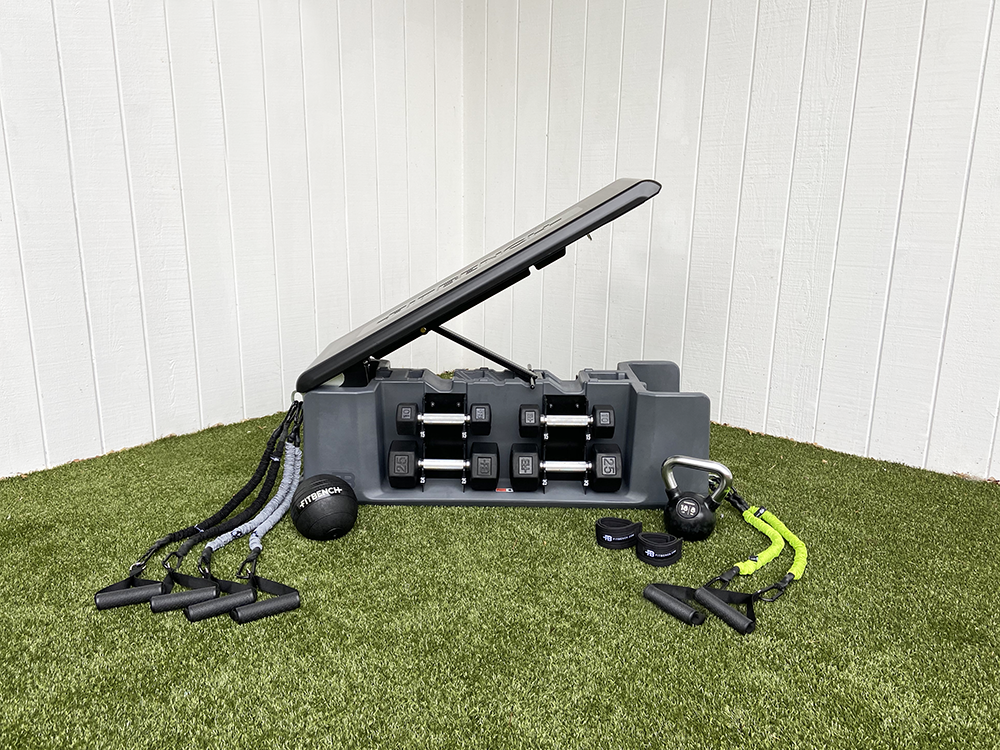

The FITBENCH FREE caters to exercisers who enjoy going to the gym for social engagement but also want the same experience at home.
The Home Fitness Market Evolves
A conversation involving wellness in the home cannot go without mentioning fitness. The home fitness market has seen a surge due to 2020’s pandemic restrictions as well as consumers’ heightened interest in controlling their health outcomes.
A report from ReportLinker [Home Fitness Equipment Market — Growth, Trends, COVID-19 Impact, and Forecasts (2021-2026)] suggests: “The North American market witnessed significant growth, due to the rising health awareness among consumers with the growing adoption of exercises related to physical well-being, weight management, improving body stamina, and muscular strength driving the market growth in the country… Furthermore, the rising preventive healthcare measures and the augmenting healthcare costs are enabling consumers to engage in regular workouts to remain fit.”
According to a report by Allied Market Research, the global at-home fitness equipment market was estimated at $5.54 billion in 2019, and is projected to reach $11.45 billion by 2027, growing at a CAGR of 7.8% from 2021 to 2027.
One of the most popular additions to the home gym is Tonal’s AI-powered total body fitness system. A spokesperson from the company shared that it “has seen unprecedented demand due to the necessity of an intelligent at-home gym during the pandemic. The adoption of smart at-home workout equipment during the pandemic has taught consumers that they should expect more from their workouts. A new demand for innovation has emerged, and we don’t expect it to slow down.”
Tonal has updated weightlifting by replacing heavy metal plates with an AI-connected electromagnetic system that assesses and coaches users, helping them set and achieve goals in an optimized and personalized way. Weights are optimized and adjusted precisely according to how much stronger a user is getting. The heart rate zone feature can be integrated with other devices, such as a heart rate monitor and Apple Watch. Tonal’s Heart Rate Zone provides data about heart rate so users can burn more calories and lift with more intensity during a workout. Users can track current heart rate zones either on Tonal or with an Apple Watch.
Tonal recently partnered with luxury retailer Nordstrom. “Partnering with Nordstrom was a natural fit for Tonal to be in front of the eyes of target customers,” said the Tonal spokesperson. “With supercharged demand, partnering with Nordstrom allowed us to quickly increase our retail footprint for prospective customers to feel the magic of Tonal before they purchase.”
Another innovator in the fitness market that realized that gym enthusiasts were searching for similar solutions at home is Tyler Danen, founder of FITBENCH. Having worked in sales for a decade for Woodway, a treadmill manufacturer, and with IronMan experience behind him, Danen noticed a need for a consolidated solution to house gym accessories, creating the product five years ago. Originally designed for commercial use in boutique studios, the FITBENCH was increasingly admired and requested for home use.
Danen introduced the FITBENCH FREE last month to cater to exercisers who enjoy going to the gym for social engagement, but also want the same experience at home. He says this trend had begun before the pandemic, but COVID-19 certainly accelerated it. There are two models: naked and fully loaded. The “naked” version serves as storage for equipment the user already owns, and the fully loaded version comes with resistance bands, four sets of weights, a Slamball, and a kettlebell.
“Going forward, I believe there is going to be a flex model, where people are working out a couple of days at home, and then a couple of days in the gym,” Danen said.
The product, which Danen describes as functional bench storage, is also completely manufactured in the U.S., and will soon be paired with an app, where users can follow interactive workouts with trainers. It can stream to any device and will feature Feed.FM, which provides curated playlists for workouts.
Moving Forward
The key word here is “moving.” It seems that consumers will continue to accelerate the movement trend. According to a June 2021 report from RunRepeat, “Fitness Trends 2021: New Trends in Fitness,” the three fastest-growing fitness trends amongst active adults: at-home fitness equipment (up 49.6 percent); personal trainers/nutritionists (up 47.5 percent); and online fitness courses, classes, and subscriptions (up 16.8 percent). The report, which surveyed 4,538 active adults from 122 countries, also stated that home fitness is growing explosively among active Americans and gym members. There were significant increases in both at-home fitness equipment (up 218.3 percent) and online fitness (up 134.7 percent). Gym members also saw significant increases in both at-home fitness equipment (115.9 percent) and online fitness (93.3 percent).
SUMMARY:
- There has been an increase in technology adoption to manage/
monitor health outcomes. - User-controlled health monitoring has been a growing trend, further impacted by the pandemic.
- At-home fitness has exploded to complement the growing interest in health and well-being.


HEALTH & WELLNESS
Who Needs FDA Rules For Health Devices?
Proposed rule changes in hearing aids reflect how long it takes regulations to catch up with technology.
BY JOHN R. QUAIN
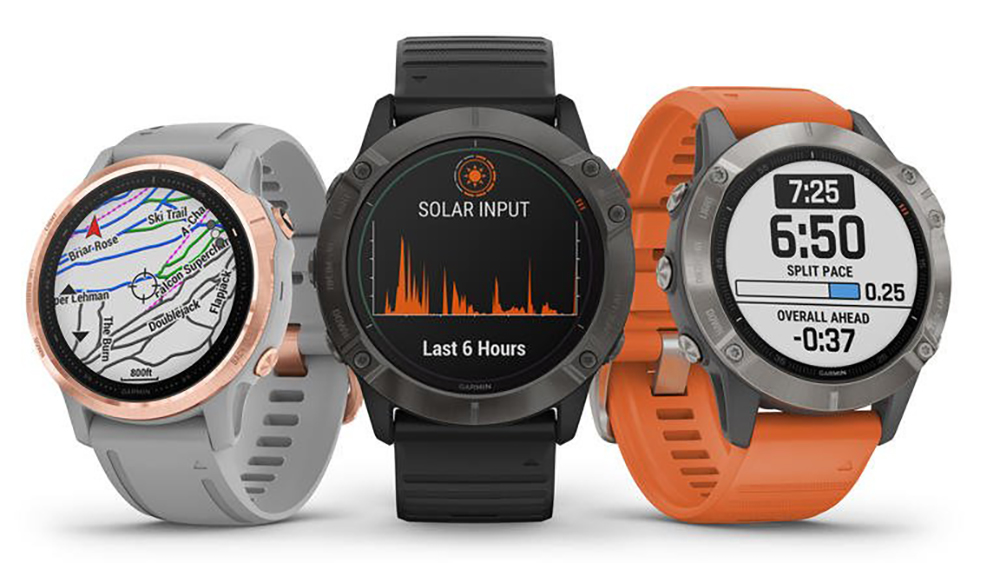

Research is under way to determine if smartwatches such as the Garmin Fenix, above, can detect COVID-19 based on subtle changes in heart rate, sleep patterns, and blood oxygen levels.
Buried deep within a July 9th executive order from President Biden was a directive to the Secretary of Health and Human Services to promote the sale of low-cost hearing aids, and for the FDA to propose new rules to allow the sale of such hearing aids over the counter. Out of more than 70 directives in the executive order on promoting competition in the American economy, it was a brief but telling mention about the struggle to get new healthcare technologies to consumers.
For years, developers have wrestled with the question of whether to market particular devices for wellness purposes, or to seek FDA approval for medical use and thus establish their legitimacy and standing for consumers. The extra step means facing the challenges and expense of conducting clinical trials to demonstrate that a device, say, accurately diagnoses atrial fibrillation. And then there’s the issue of educating consumers about a new technology so that the devices aren’t subjected to misuse and abuse. Hypochondriacal owners could suffer needless anxiety and hospital visits due to misinterpreting blood oxygen saturation readings, for example, while an ill-fitting fitness band could fail to capture critical cardiac information needed to warn of an impending heart attack.
So why has there been such hype and emphasis on FDA approval over the years? Here’s a breakdown of the major issues:
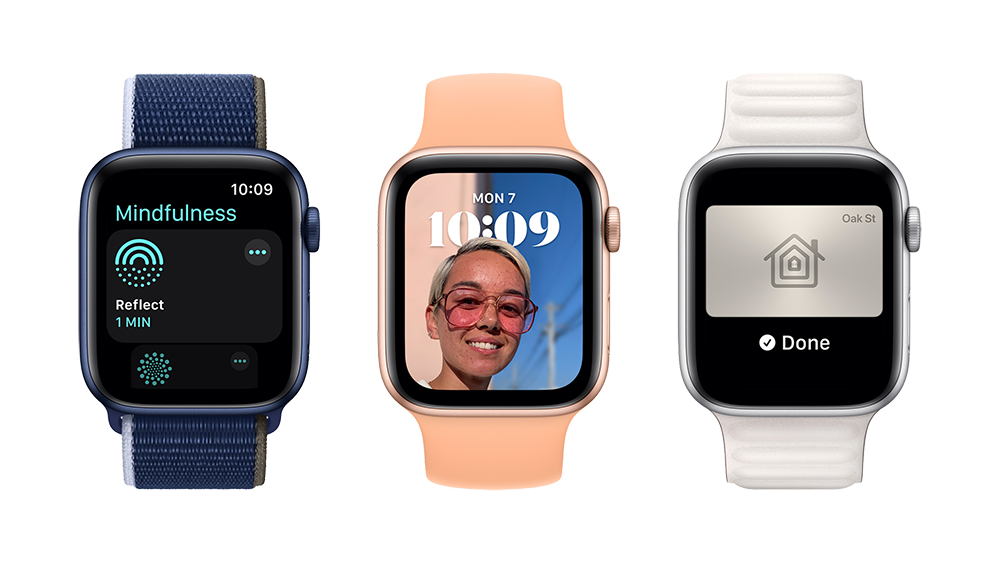

Apple’s watchOS 8 added mindfulness, sleep respiratory rate tracking, Tai Chi and Pilates workouts.
Why is FDA approval or a status change important?
The main issues are about access and cost to the consumer. In the name of protecting consumers, new technologies and devices may be barred from being sold over the counter and thus, from reaching customers. That has been the case with hearing aids in the United States, where they have been prescription products and, depending on state laws, could only be sold via a licensed practitioner, such as a physician or audiologist. It meant getting relief from mild-to-moderate hearing loss was an expensive proposition, requiring an exam and the purchase of devices often costing thousands of dollars. It also stymied competition with the four largest hearing aid manufacturers controlling 84 percent of the market, according to the White House.
“The over-the-counter rule means it will cost $500 to $600 for really good hearing aids — versus $5,000 to $6,000,” explained Tom Hannaher, CEO of Zvox. His company already sells such VoiceBud VB20 Hearing Aids online directly to consumers for as little as $300.
What kinds of devices are we talking about?
A wide array of technologies and devices promises to transform health and wellness by offering less expensive, more pervasive gadgets that can monitor everything from pulse rates to stress levels to blood oxygen saturation. Foremost among these are smartwatches and fitness bands, of course, which have taken on a renewed interest since the beginning of the COVID-19 pandemic. Indeed, there are several research studies under way to see if smartwatches like the Apple Watch and Garmin Fenix can reveal that otherwise asymptomatic people are infected with the virus, based on subtle changes in their heart rate, sleep patterns, and blood oxygen levels.
There are other devices, like LED headbands that purport to grow hair, that are unlikely candidates for FDA approval. Indeed, the primary purpose of the FDA imprimatur is to protect consumers from devices that do not work as advertised. However, with the increasing miniaturization of sensors, you can expect to see more fitness- and health-related wearable computing devices, such as shirts that can monitor a wearer’s vital signs, that may in the future become candidates for FDA approval.
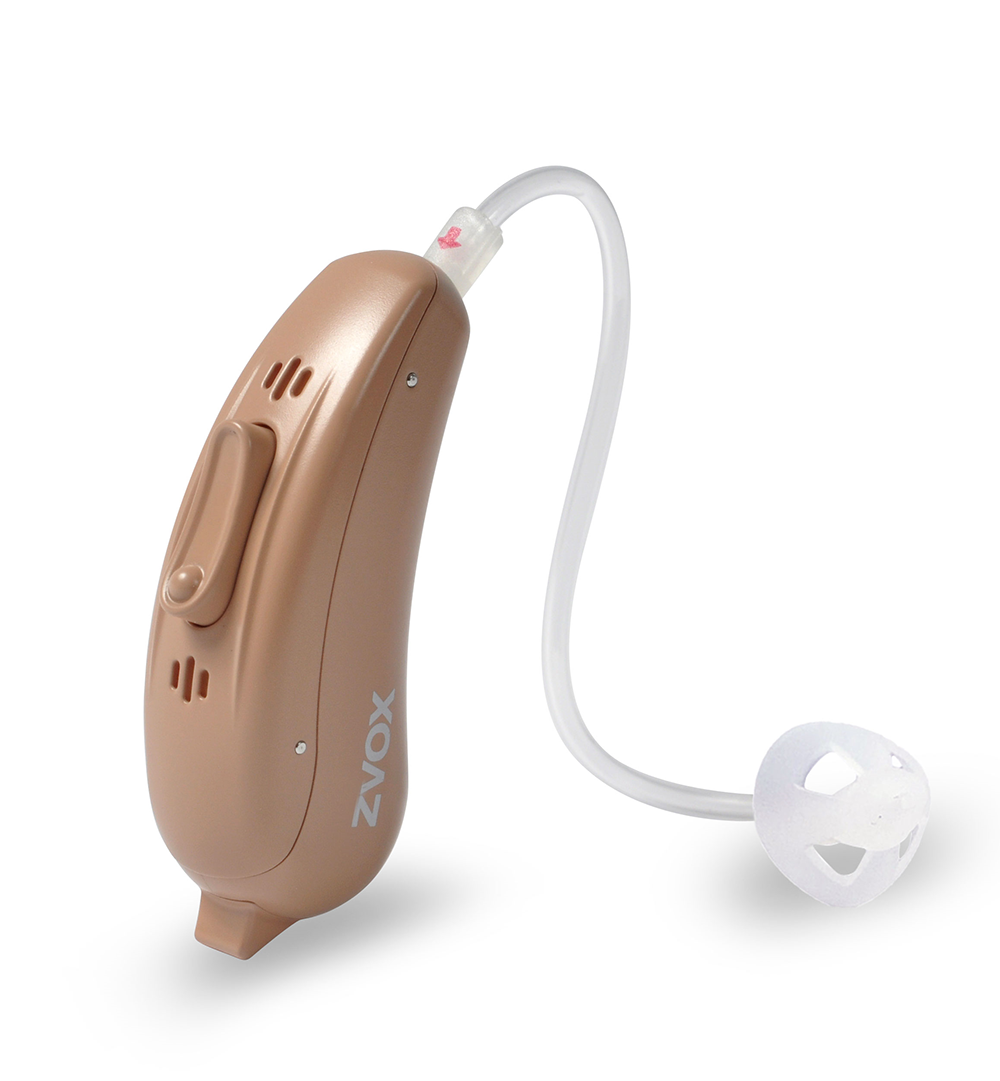

Zvox sells its VoiceBud VB20 hearing aids online directly to consumers for as little as $300.
How long does FDA approval take?
The answer is, it depends. For an individual device, a company can request recognition and sometimes receive relatively quick approval — but usually only after submitting substantial evidence in the form of clinical trials that the device works for its intended use, and that could take months, if not years. And then the approval only applies to the single device, such as the Apple Watch for electrocardiograms (ECG), but not to the whole category of smartwatches or for all their potential uses.
Changing the FDA rules for an entire class of devices takes more time. For example, President Biden’s executive order gives the FDA 120 days to come up with new rules for hearing aids. Once those are published, there’s a 60-day public comment period, and then the FDA has another 180 days after that to issue final rules for over-the-counter retail sales. That’s a total of about 12 months, assuming there are no objections or other procedural delays. And delays are common; the original legislation allowing for over-the-counter hearing aid sales was signed in 2017.
Should these devices really get FDA approval?
It depends on who you ask, and what issues FDA approval will address. Some doctors and researchers do not think smartwatches, for example, should get FDA approval.
“These devices are helpful aids and should be used as another tool in the kit,” says Dr. Tyrone Krause, chief of Cardiothoracic and chair of Surgery at Jersey City Medical Center. “In other words, each person is different with different circumstances, on different medications, etc.” Dr. Krause says it’s also not a question of accuracy. Heart rate monitors and oxygen saturation sensors are reasonably precise, but the measurements are meaningless unless they are placed within the context of the person’s overall health situation.
On the other hand, many of these unapproved devices are being purchased and used by consumers as healthcare instruments. So FDA guidance and rules governing these gadgets could help prevent them from being misused or misrepresented.
“There’s a risk that you get something that doesn’t work,” says Thomas Powers, an audiologist who consults for the hearing health industry, including Zvox. And while he thinks there is minimal risk in over-the-counter hearing aids doing damage to a person’s deteriorating hearing, the forthcoming FDA guidelines should include helpful rules about the maximum amplification such devices will be allowed to provide in order to prevent any potential injury.
Ultimately, it may be these kinds of rules that represent the best path going forward for new technologies designed to improve health and wellness. New FDA rules and guidelines tailored specifically to these new devices could speed adoption and give consumers and retailers a better understanding of what the technologies are good for — and what they are not good for.
STAT SHOT
CE Industry By Numbers
COMPILED BY SAM HITT
30
…centimeters, which is the width of LG’s new Eclair sound bar. The Eclair is only one-third the size of a standard sound bar, yet it still boasts speakers with 320-watt output.


50%
… the projected increase in electric vehicle (EV) range with the use of Daikin Industries’ new refrigerant, which makes heating and cooling systems more efficient. The new refrigerant has a boiling point that is 10 degrees Celsius to 15 degrees Celsius lower than the refrigerant currently being used in EVs. The new refrigerant requires less power to heat and cool the car, allowing for the vehicle to travel farther on the same amount of charge.


1.2%
… is the percentage that e-commerce sales grew in June 2021 on a month-over-month basis, according to a July 16 report from the U.S. Department of Commerce. The surge has been attributed in part to the popularity of Amazon Prime Day.
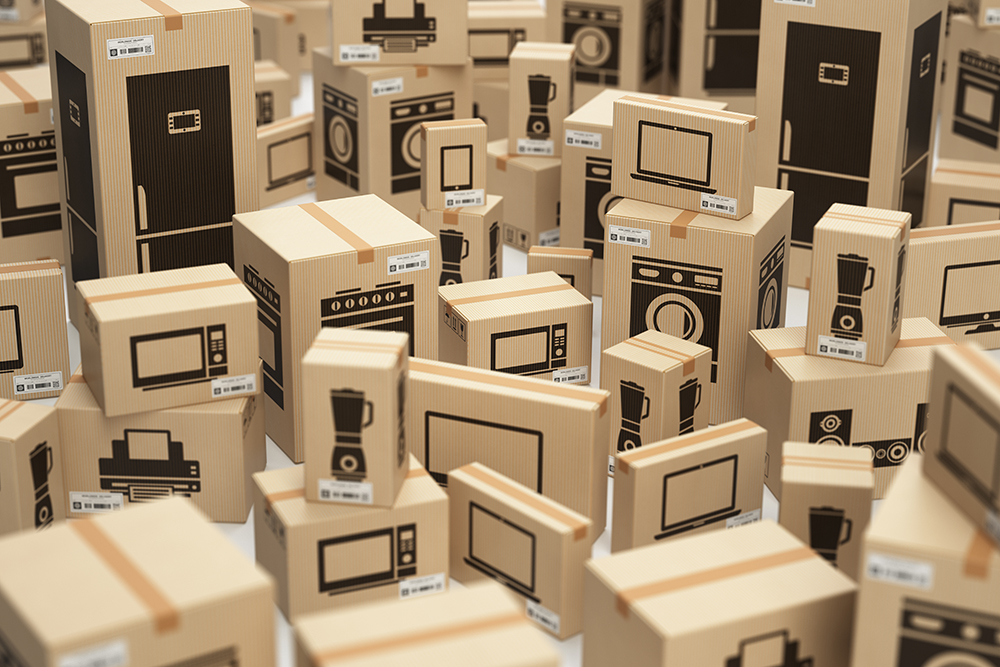

19
… The number of Chinese electronics brands banned by Amazon, surrounding the controversy over abuse of Amazon’s review system. The infractions from these companies include gifting free merchandise in exchange for reviews. The net sales from these suspended brands is roughly $1 billion.


$1.25 bn
… the price Chinese tech company Tencent has paid to acquire Sumo Group, a U.K.-based video-game developer. Tencent, the owner of WeChat, adds Sumo Group to its list of game developers, which already includes full ownership of Supercell and Riot Games, as well as part ownership within Activision Blizzard, Epic Games, Voodoo, Frontier Developments, and Ubisoft.
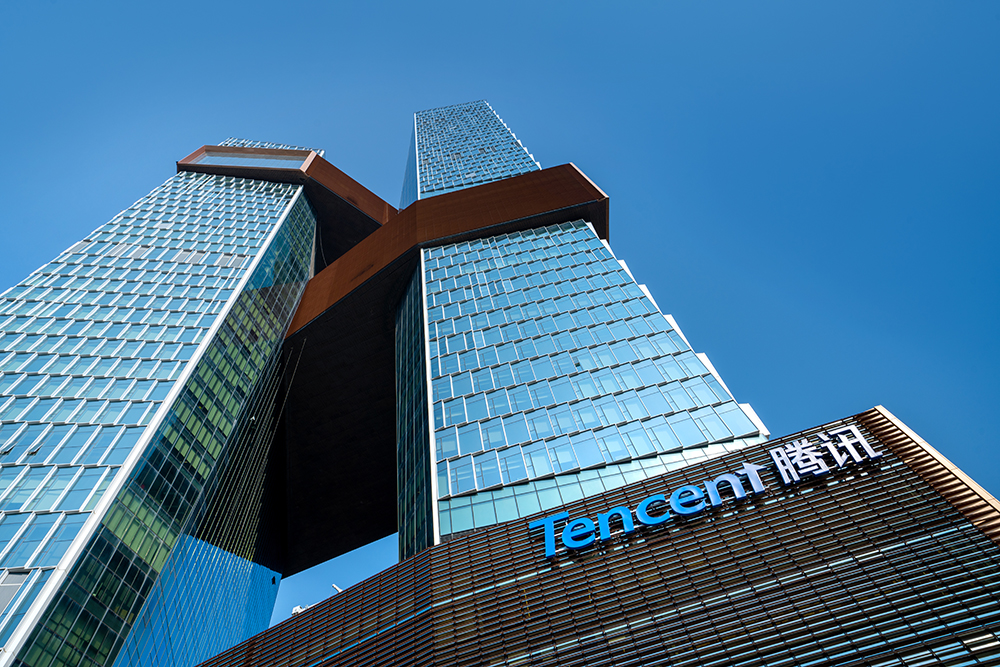



CONSUMER TECHNOLOGY CALENDAR
Upcoming Events
August 5, 2021
AV/IT Summit Virtual
avitsummit.com
August 15-18, 2021
Nationwide PrimeTime
nationwideprimetime.com
August 18, 2021
Parks Associates CONNECTIONS
State of Home Security Market
parksassociates.com/events/connections-us
August 21-24, 2021
AVB Convention
avbevents.com/convention
September 1-3, 2021
CEDIA Expo
cediaexpo.com


WHAT’S UP
ROBERT ZOHN
We asked the President and Founder of Value Electronics in Scarsdale, New York to share what’s on his mind right now.
COMPILED BY TONY MONTELEONE
1. What has been happening in the last couple of months in your business sector?
Every spring/summer marks the new model year for TVs. This year’s new TV models have more significant video display technology upgrades and enhancements that exploit the abilities of the new 4K HDR TV Video System. Brighter OLED TVs not only deliver brighter images and better HDR and improved DCI P3 with good color saturation and full-color volume, but also give the users another technical advantage that has not been discussed yet, and that’s the much larger dynamic tonal range. The larger dynamic tonal range that is only possible with LG’s G1 Gallery Series and Sony’s A90J Master Series OLED TVs gives the images more detail, and the perception is a sharper and a more real-to-life detailed picture.
Larger screen sizes with these new high-performance OLED TVs are now available up to 83 inches, ranging from 55-, 65-, 77- and now the 83-inch class.
Samsung’s new Neo series includes a beautiful range of 4K and 8K MiniLED TVs in sizes from 55 to 85 inches. LG is soon to follow with their same range of 4K and 8K MiniLED NED TVs from 55 to 86-inch screen sizes.
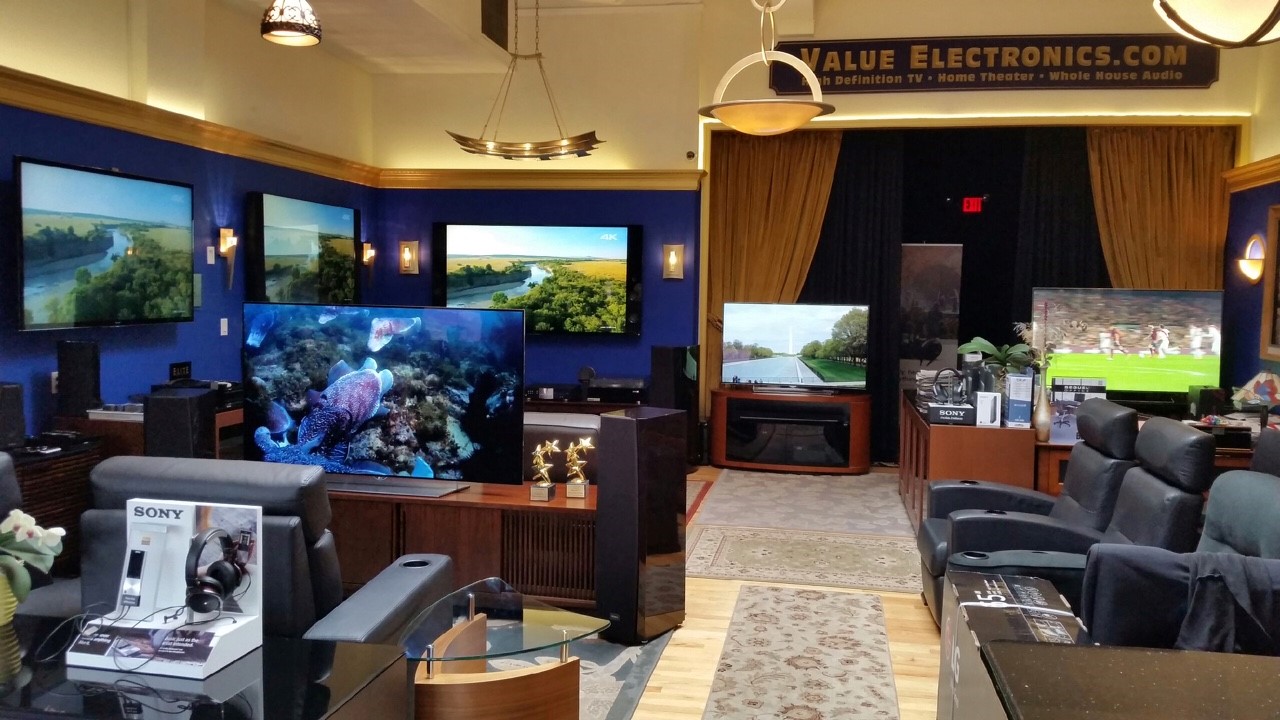

Inside Value Electronics – Home Theater section
2. What excites you most about the next two months as it relates to your business? What most concerns you?
As our loyal early-adopter customers begin to rave about their new TVs, sales will continue to maintain a strong and steady pace. Adding to the excitement of the new TVs launching is the anticipation for our 2021 TV Shootout Evaluation event.
3. What is the most important thing for our readership to know about your business?
We are the go-to retailer for a premium experience in audio and video. We apply our love for premium A/V performance systems to every price level we sell. Our tech support field service teams integrate/install in your home or business.
Our very popular e-commerce reach is the contiguous 48 U.S. states where we include delivery to your home at no charge for our customers.
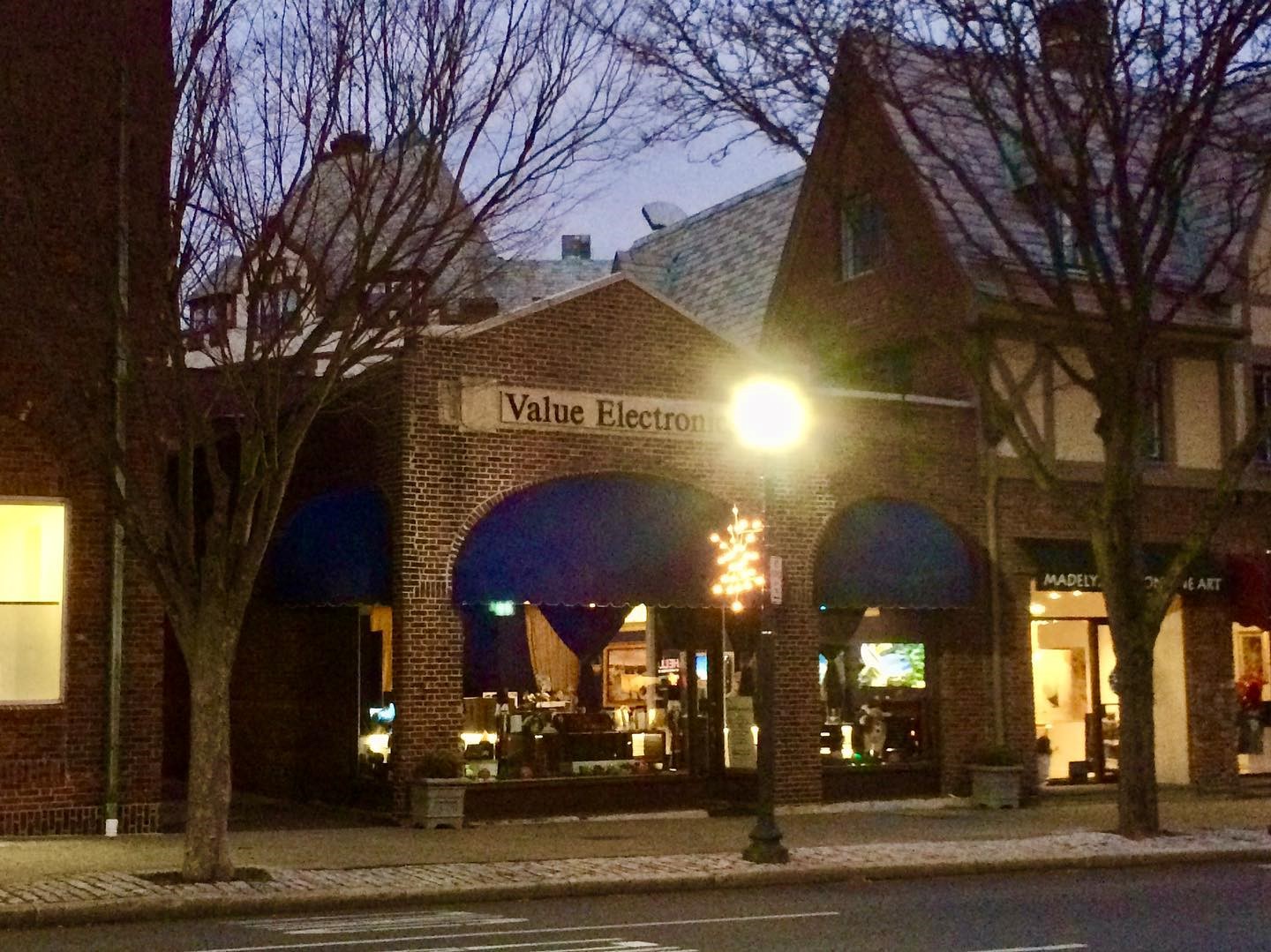

Outside Value Electronics in Scarsdale, NY
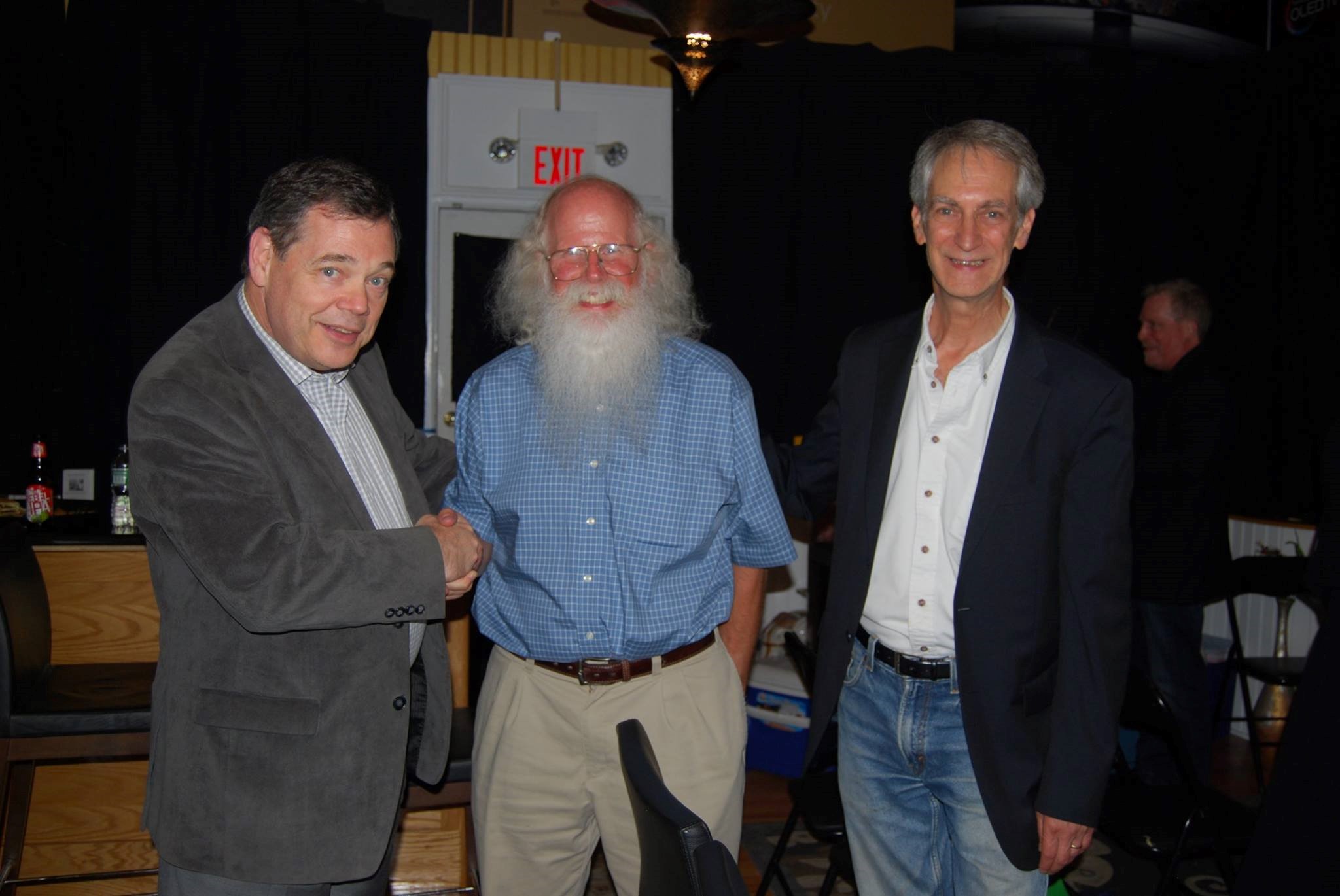

Joe Kane (left), plasma TV inventor Dr. Larry Weber (center), and Robert Zohn (right) at one of Value Electronics’s TV Shootout events.
4. How can our readers best get in touch with you, or become involved in what you are doing for the industry? What websites can they check out for news or activity updates about your organization?
Our company url is www.ValueElectronics.com and our clients can reach us by phone 914-723-3344 or email at rzohn@valueelectronics.com.
Also check us out on social media:
Facebook www.Facebook.com/ValueElectronics
Instagram www.instagram.com/ValueElectronics Youtube www.youtube.com/ValueElectronics and www.youtube.com/TVShootout


Pic of our TV Shootout in our store.
5. Why is our publication relevant to the people you serve with your organization?
Being a retailer to end-users, trade publications would not normally be considered of value to our customer base. But in our case of catering to the mid-range to premium and luxury markets, our enthusiast clients read Dealerscope, as they want to keep updated on the A/V companies, products, and news updates. Dealerscope and other trade publication articles of interest are shared on our social media.
DEALERSCOPE PODCAST
Welcome to the Dealerscope Podcast – Your Source for all B2B trends in Retail, Tech and Biz!
In the high-strung consumer electronics retail business, it can be hard to take a moment to step back and breathe. The Dealerscope Podcast gives CE retail leaders the chance to kick back, relax, and talk shop in a casual setting.
Refresh Your Subscription!
Get Dealerscope and Connected Design delivered to your doorstep or to your email.
How, where and when we work has changed dramatically. We realize that these changes in your work habits may have impacted how you receive your issues.
Click on the links below to update how and where you receive your issues! Change your mailing address or request a change from print to digital, or just head to our websites.
PA OFFICE:
230 South Broad Street, 17th floor
Philadelphia, PA 19102
NY OFFICE:
31 Hudson Yards, New York, NY 10001
E-Mail: dealerscope@ctlab.media


EDITORIAL
EDITOR IN CHIEF
Tom Samiljan
tsamiljan@ctlab.media
CHIEF EDITOR DIGITAL CT LAB
Jessica Guyon
(267) 266-1432
jguyon@ctlab.media
CONTRIBUTORS
Stephanie Adamow
Paul Hales
Sam Hitt
Nancy Klosek
Erinn Loucks
John R. Quain
Giles Sutton
David Xing
CREATIVE
Astrid von Krenski
(940) 727 8595
avkrenski@ctlab.media
EDITORIAL OFFICES
230 South Broad Street, 17th Floor
Philadelphia, PA 19102
www.dealerscope.com
CHIEF OPERATING OFFICER
Alice Schmalzl
(940) 612-9581
aschmalzl@ctlab.media
GROUP PUBLISHER
Tony Monteleone
(718) 216-2046
tmonteleone@ctlab.media
VIDEO
Alexander Oswald
aoswald@ctlab.media
OPERATIONS MANAGER
Vicki Manucci
vmanucci@ctlab.media
CIRCULATION & DISTRIBUTION
Carrianne Ramsey
cramsey@ctlab.media
Reprints
Contact Publisher
List Rental, Postal/E-mail
Contact Publisher
Publisher of Dealerscope, and Connected Design
Copyright ©2021 CT Lab Global Media LLC
CT Lab Global Media is a diversified publisher of business and professional magazines. This publication is provided with the express understanding and agreement that the information and data within it will be solely for internal use and will not be used for the creation or updating of mailing lists for sale or distribution to third parties. Printed in the U.S.A.

